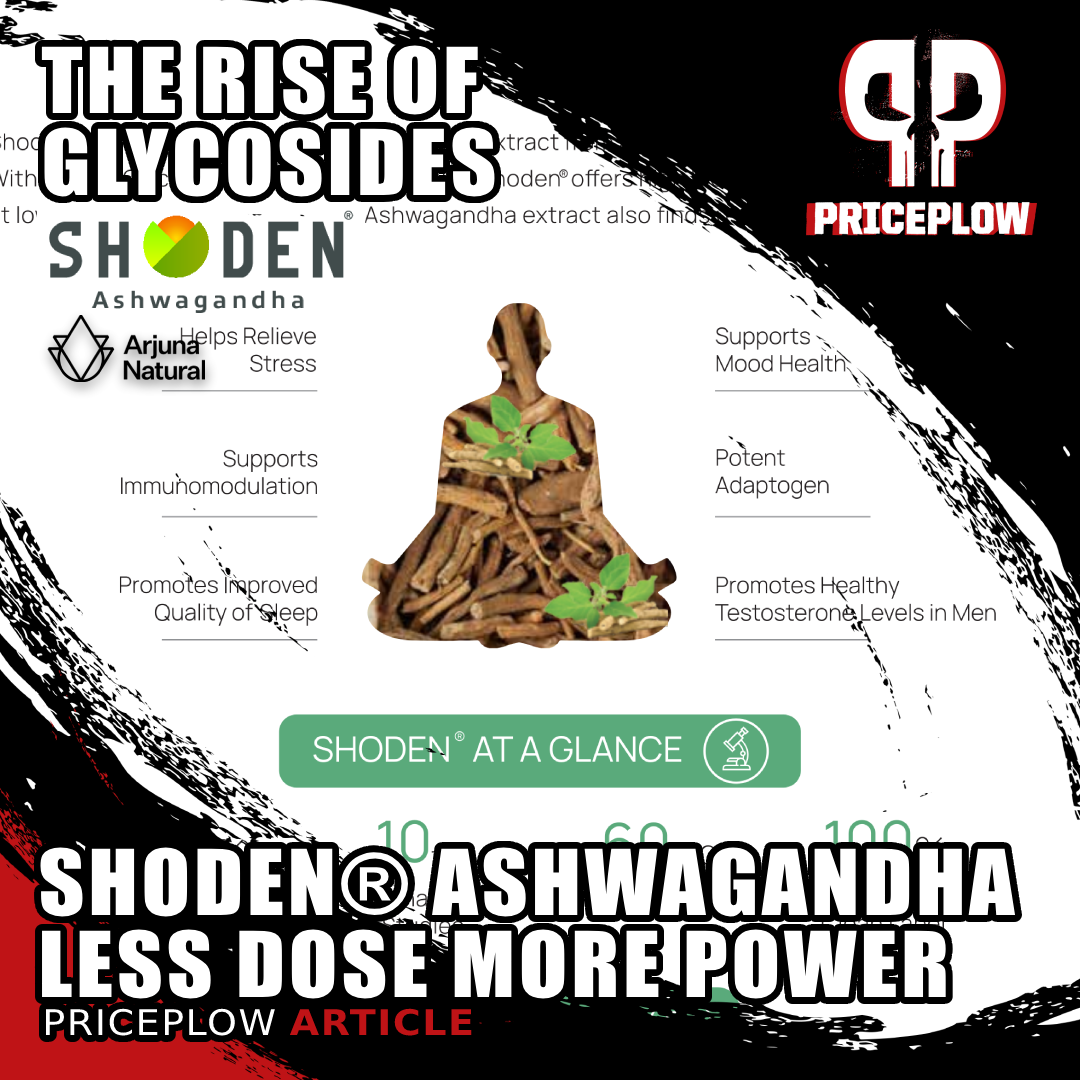
Shoden brings a new era to ashwagandha supplements with 35% glycowithanolide standardization. Research shows it delivers powerful effects at just 60-120mg daily, compared to 600mg+ with traditional extracts.
In a supplement industry dominated by synthetic compounds and artificial ingredients, one ancient herb continues to captivate both researchers and consumers alike: Ashwagandha. This adaptogenic powerhouse from Ayurvedic tradition has seen an unprecedented surge in popularity, with scientific research validating what traditional medicine has known for millennia.[1]
But as more consumers turn to this traditional Ayurvedic herb for hormone support (including testosterone) and relief from stress, anxiety, and sleep troubles, a concerning trend has emerged in the industry: not all ashwagandha extracts are created equal.
A Growing Need for Enhanced Ashwagandha Standardization
However, this rising popularity has exposed a critical challenge in the supplement industry. The problem lies in the standardization – or lack thereof. While numerous brands now include ashwagandha in their formulations, the quality, potency, and effectiveness of these extracts vary dramatically.
The core issue lies in how these extracts are standardized and tested – with outdated methods that don't tell the complete story, failing to capture the full spectrum of bioactive compounds that make ashwagandha so effective. This has led to inconsistent results and varying degrees of effectiveness across different ashwagandha supplements.
Enter Shoden, a revolutionary ashwagandha extract from Arjuna Natural that's changing the game through its focus on the most bioavailable form of withanolides: glycosides. With a scientifically-validated 35% glycowithanolide content – the highest in the industry – Shoden represents the next evolution in ashwagandha supplementation, demonstrating powerful effects at far lower doses than traditional extracts.[2]
This isn't just another ashwagandha extract – it's a precisely engineered botanical supported by multiple clinical trials showing superior absorption and effectiveness. We're diving deep into the science behind this breakthrough ingredient, but first, sign up for PricePlow's Shoden alerts to get notified about new products and deals:
Subscribe to PricePlow's Newsletter and Alerts on These Topics
What is Ashwagandha?
For over 3,000 years, healers in India's traditional Ayurvedic medicine system have turned to a special herb known as Ashwagandha (Withania somnifera) to help with everything from stress and anxiety to testosterone production to inflammation and immune support.[3]
The name itself tells us much about its historical use – "Ashwa" means horse in Sanskrit, while "gandha" means smell. This refers not only to the distinct horse-like scent of its roots, but also to the traditional belief that consuming it would impart the strength and vitality of a stallion.
Ancient Wisdom Meets Modern Science
As one of Ayurveda's most revered adaptogenic herbs, Ashwagandha holds a special classification as a "Rasayana" – a term reserved for substances that promote physical and mental health, restore youth, and enhance overall life quality.[4] Think of Rasayanas as the premium tier of Ayurvedic medicine, used not just to treat specific conditions, but to optimize overall well-being.
What's fascinating about Ashwagandha is how it bridges ancient wisdom with modern science. While ancient texts praised its ability to enhance "Ojas" (vital force) and promote "Bala" (strength), today's research has backed up their use for these purposes and identified the specific compounds responsible for these effects. These compounds are primarily withanolides, naturally-occurring steroidal lactones that have become the subject of intense scientific scrutiny. Researchers continue to discover their remarkable effects on everything from stress hormone regulation to immune system function.[5]
In its natural habitat, Ashwagandha grows as a robust evergreen shrub, reaching heights of about two to three feet. While the entire plant contains beneficial compounds, traditional Ayurvedic practice primarily utilized the root, which was typically dried and ground into a fine powder. This powder would then be mixed with warm milk, ghee (clarified butter), or honey – delivery methods that, interestingly, modern science suggests may actually enhance the bioavailability of its active compounds.[6]
However, as we'll learn, ashwagandha leaves provide numerous beneficial compounds as well, complementing the roots quite synergistically.
The Modern Ashwagandha Renaissance
The past decade has seen an unprecedented surge in both scientific research and consumer interest in ashwagandha. What was once primarily known in traditional Indian medicine has become one of the fastest-growing supplements in the Western world. This growth has been driven largely by increased research validating its traditional uses – particularly its effects on stress, anxiety, and sleep quality.[1]
Researchers have conducted hundreds of studies on ashwagandha in recent years, with investigations ranging from its effects on exercise performance to its potential neuroprotective properties. This explosion of research has revealed that ashwagandha's benefits extend far beyond its traditional applications, showing promise in areas like cognitive enhancement, thyroid function support, and even cellular health.[7]
Understanding Ashwagandha’s Active Compounds
The secret to ashwagandha's diverse effects lies in its rich composition of bioactive compounds. While the plant contains numerous beneficial substances, the most important class is the withanolides – the primary drivers of ashwagandha's therapeutic effects.[8]
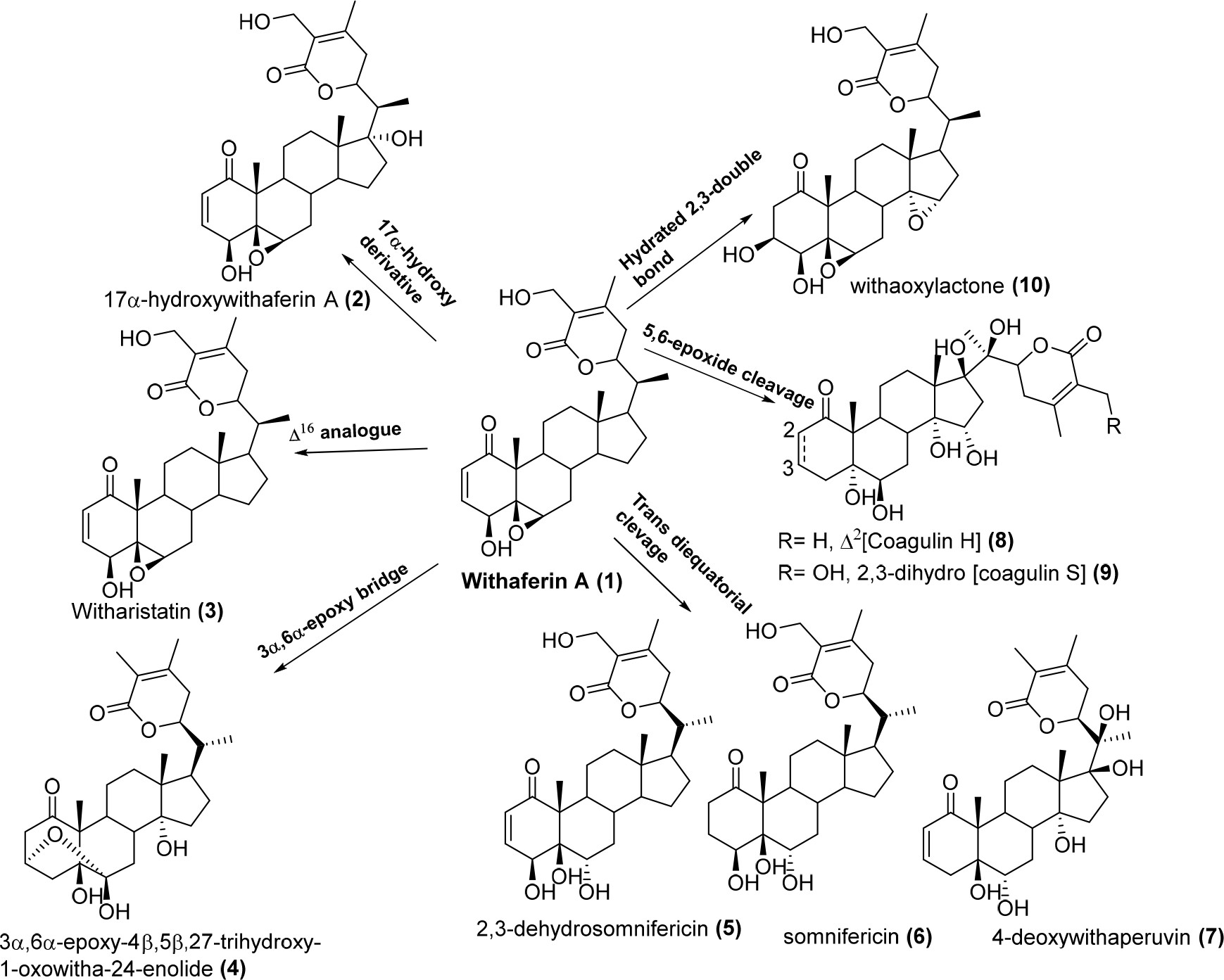
Chemical structure diagram showing the transformation pathways of Withaferin A (1) into various derivatives, including witharistatin, hydroxy derivatives, and withaoxylactone.[8]
-
The Withanolide Family
Withanolides can be broadly categorized into two main groups:[2]
- Withanolide Aglycones: These are the "free" form of withanolides, including well-known compounds like:
- Withaferin A
- Withanolide A
- Withanone
- 12-deoxywithastramonolide
- Withanolide Glycosides: These are withanolides bound to sugar molecules, which can significantly affect their absorption and bioavailability. Key glycosides include:
Comprehensive diagram illustrating the chemical pathways from Withaferin A to various withanolide derivatives, including glycosides and hydroxy-substituted compounds.[8]
- Withanoside IV
- Withanoside V
- Withanoside VI
Chemical structure map showing the transformation of Withaferin A into various specialized withanolides, including acetyloxy derivatives and α-hydroxy withanolides.[8]
What makes this distinction important is that these different forms can have varying levels of bioavailability and effectiveness in the body. Recent research has shown that glycosidic forms may offer superior absorption and sustained activity compared to their aglycone counterparts.[2]
- Withanolide Aglycones: These are the "free" form of withanolides, including well-known compounds like:
-
Beyond Withanolides
While withanolides get most of the attention, ashwagandha contains several other important compounds that contribute to its effects:[8]
Chemical structures of Withanamides A-I (79-87), showing the variety of glycosylated and non-glycosylated forms of these bioactive compounds found in ashwagandha.[8]
- Flavonoids: Such as quercetin derivatives and kaempferol
- Saponins: These may enhance the absorption of other compounds
- Vitamin and Minerals: Including choline and iron
This complex array of compounds works synergistically, creating what scientists call an "entourage effect" – where the combined action of multiple compounds produces greater benefits than any single compound alone.[5]
-
Supporting the Entourage Effect with Ashwagandha Leaves
One interesting development in recent research has been the discovery that ashwagandha's leaves, traditionally less utilized than the roots, contain valuable compounds that complement those found in the roots. This has led to new extraction methods that utilize both plant parts to create more comprehensive extracts,[7] leading to modernized extracts that are disrupting the adaptogen market.
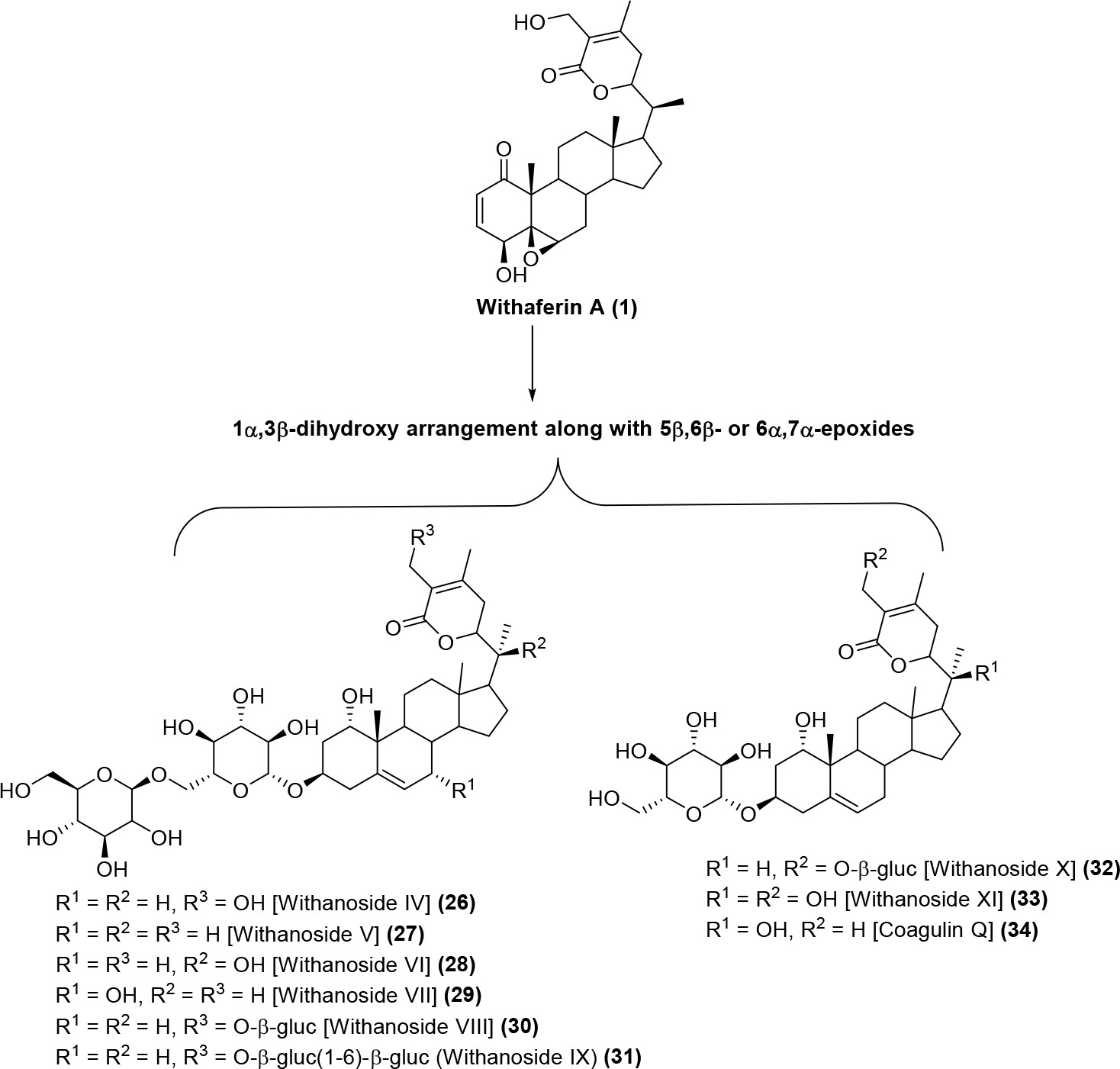
Detailed chemical structures showing various withanosides (26-34) and their relationship to Withaferin A, emphasizing dihydroxy arrangements and epoxide variations.[8]
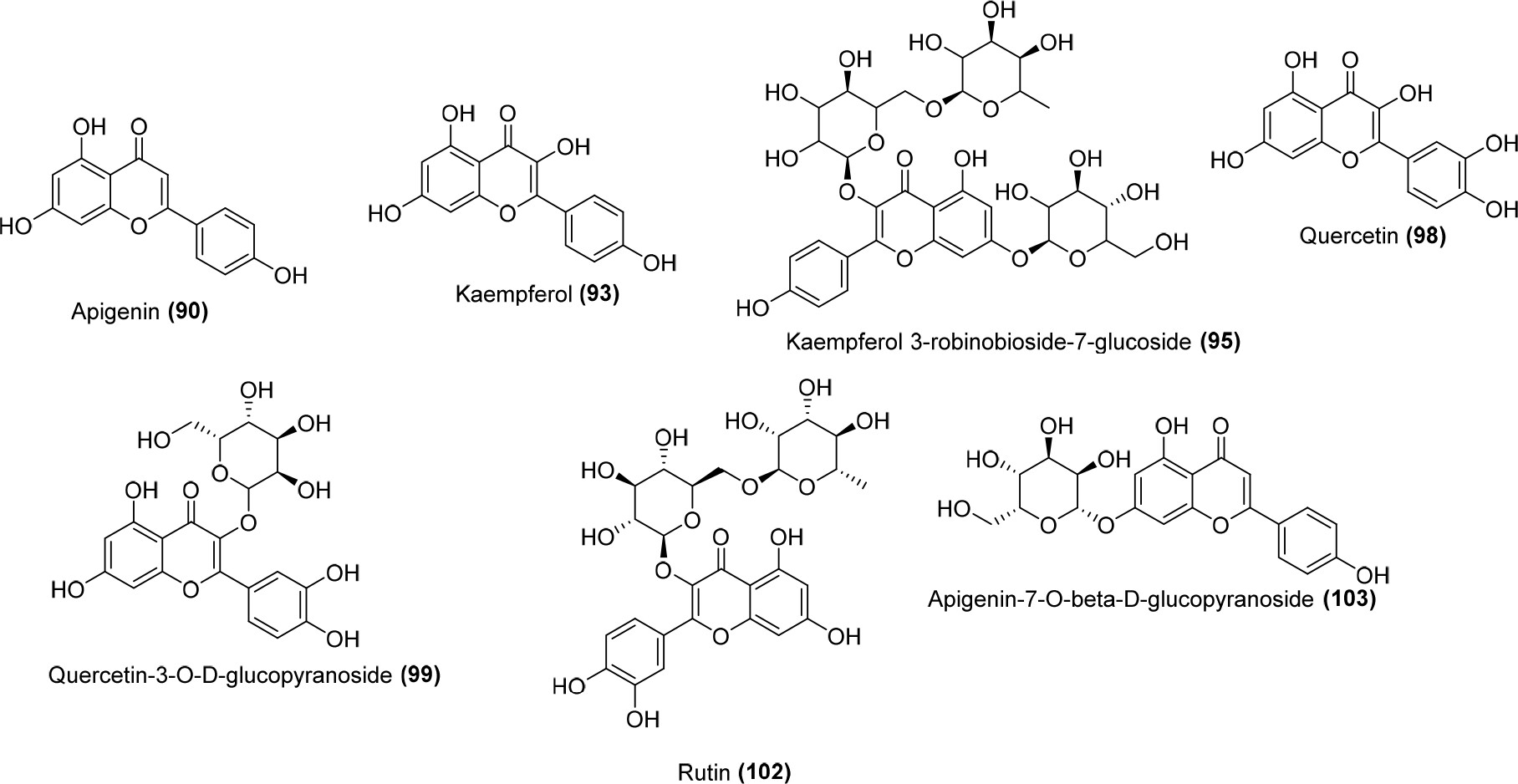
Chemical structures of key flavonoids including apigenin, kaempferol, quercetin, and their glycosylated derivatives found in Withania somnifera extracts.[8]
The Current State of Ashwagandha Extracts
The booming popularity of ashwagandha has led to a flood of different extracts on the market, but this rapid growth has created significant challenges for both consumers and manufacturers. Let's explore the complex landscape of ashwagandha extracts and understand why standardization has become such a critical issue.
-
The Standardization Challenge
The biggest challenge facing the ashwagandha market today stems from inconsistent standardization methods. While most extracts advertise their "withanolide content", the reality is far more complex. Different testing methods can yield vastly different results, even when measuring the same extract.[8]
Raw ashwagandha roots alongside their powdered form on natural burlap, representing the traditional preparation method that has been used for over 3,000 years in Ayurvedic medicine.
The Industry’s Glycoside Oversight
For years, manufacturers have standardized their ashwagandha extracts for total withanolides without recognizing the critical difference between glycosides and aglycones. Most extracts contain higher levels of aglycones than glycosides.[2]
This is problematic because not all withanolides are equally bioavailable or effective.[2] An analogy is that all apples are fruits, but not all fruits are apples -- similarly, all withanolide glycosides are withanolides, but not all withanolides are withanolide glycosides.
-
The Root of the Problem
Another significant issue lies in the plant parts used for extraction. Traditionally, ashwagandha root has been the primary focus, but research has shown that the leaves contain valuable compounds as well. Some manufacturers use only roots, others combine roots and leaves, and still others may use different plant parts entirely – all while claiming similar standardization levels.[7]
The industry currently lacks standardized guidelines for:
- Which plant parts should be used
- Which compounds should be measured
- Which testing methods should be employed
- How results should be reported
The result is a fragmented category with poorly-standardized and even more poorly-tested extracts.
-
Understanding Extract Types
Today's market features several different types of ashwagandha extracts:
Flowchart detailing both conventional and non-conventional extraction methods for Withania somnifera, highlighting critical aspects and compound classes obtained.[8]
-
Full-Spectrum Extracts
These aim to preserve the natural ratio of compounds found in the plant, potentially supporting the "entourage effect" where multiple compounds work together synergistically.[5] However, the term "full-spectrum" isn't regulated, and its meaning can vary between manufacturers.
-
Standardized Extracts
These focus on guaranteeing specific levels of withanolides, but the methods used for standardization and testing can vary significantly. Some focus on total withanolides, while others target specific compounds or forms.[8]
-
Root-Only vs. Root-and-Leaf Extracts
Each approach has its advocates, with root-only extracts following traditional usage patterns, while root-and-leaf combinations aim to capture a broader spectrum of beneficial compounds.[7] The choice between them often comes down to the specific extraction and standardization methods used.
-
-
The Need for Better Standards
The current landscape clearly demonstrates the need for more rigorous standardization in the industry. Consumers deserve to know not just how much withanolide content their supplement contains, but also in what form these compounds exist and how bioavailable they are. The future of ashwagandha supplementation will likely depend on advanced extraction methods and testing protocols that can provide this level of detail and transparency.
Understanding Withanolides: The Key to Ashwagandha’s Effects
Before we dive deeper into the benefits of ashwagandha supplementation, it's crucial to understand the molecules responsible for its effects. Withanolides are the primary active compounds, but not all withanolides are created equal – their form significantly impacts their effectiveness.
-
Glycosides vs. Aglycones: A Critical Distinction
Withanolides exist in two main forms:
- Aglycones - The "free" form of withanolides
- Examples include withaferin A and withanolide A
- More commonly measured in traditional extracts
- Generally less stable and more rapidly metabolized
- Glycosides - Withanolides bound to sugar molecules
- Include compounds like withanoside IV and V
- More stable in the digestive system
- Often show superior absorption patterns[2]
- Aglycones - The "free" form of withanolides
-
The Bioavailability Advantage
Recent research has revealed that glycosidic forms of withanolides demonstrate significant advantages in terms of:[2]
Comprehensive infographic detailing Shoden's key benefits, including stress relief, sleep quality improvement, and testosterone support, alongside its technical specifications of 35% withanolide glycosides and versatile 60-240mg dosage range.
- Absorption rates
- Time spent in circulation
- Overall biological effectiveness
In fact, studies show that glycoside forms can achieve higher withanolide blood concentrations and remain active in the body significantly longer than their non-glycoside counterparts.[2]
-
Why Proper Standardization Matters
Most ashwagandha extracts are standardized to "total withanolides," but this measurement can be misleading because:[8]
- It doesn't distinguish between bioavailable and poorly absorbed forms
- Traditional testing methods may not accurately capture glycoside content
- Different testing methods can yield vastly different results for the same extract
-
Common Industry Pitfalls
The ashwagandha industry faces several challenges in standardization and testing:
- Outdated Testing Methods
- Many rely on basic spectrophotometric methods
- Can't differentiate between various withanolide forms
- May miss or undercount certain beneficial compounds
- Inconsistent Standards
- No universal testing protocol
- Varying definitions of "standardization"
- Limited focus on bioavailability
- Marketing vs. Reality
- Focus on total withanolide percentage without considering form
- Lack of transparency about testing methods
- Insufficient attention to absorption and effectiveness
The distinction between glycosides and aglycones represents more than just chemical terminology – it's fundamental to understanding why some ashwagandha extracts may be more effective than others, even when standardized to the same total withanolide content.[2]
- Outdated Testing Methods
Key Benefits (Research-Backed)
There are several ways in which ashwagandha can improve the mind, body, and spirit -- the first being stress relief:
-
Stress & Anxiety Reduction: The Core Benefits of Ashwagandha
Also known as Withania somnifera, ashwagandha is the dietary supplement industry's most prominent adaptogenic herbs. Image courtesy Wikimedia Commons.
When it comes to managing stress and anxiety, ashwagandha stands out as one of the most well-researched adaptogenic herbs available. Modern clinical research has validated what Ayurvedic practitioners have known for millennia - this powerful herb helps the body adapt to and manage stress while promoting a sense of calm and wellbeing.[1]
A comprehensive 2022 meta-analysis examining 12 randomized controlled trials found that ashwagandha supplementation significantly reduced both anxiety and stress levels compared to placebo treatments.[6]
The mechanisms behind ashwagandha's stress-reducing effects appear to be multifaceted. One of the primary pathways is through modulation of the hypothalamic-pituitary-adrenal (HPA) axis, which controls our body's stress response system. Research shows that ashwagandha can help reduce elevated cortisol levels - often called the "stress hormone" - bringing them back into a healthier range.[9]
Beyond cortisol regulation, ashwagandha appears to work through several other pathways:
- Enhancement of GABA signaling, promoting relaxation and calmness[10]
- Reduction of inflammation and oxidative stress in the brain[11]
- Modulation of serotonin and other neurotransmitter systems involved in mood regulation[12]
In clinical studies, the effects are remarkable. A randomized, double-blind study found that participants taking ashwagandha experienced a 44% reduction in stress scores compared to just 5.5% in the placebo group.[13]
More recent research has demonstrated that these benefits may be achieved at lower doses than previously thought. A 2024 study showed significant reductions in stress and anxiety scores at doses as low as 60mg daily of a highly concentrated extract -- Shoden.[14]
The stress-reducing effects typically begin to manifest within a few weeks of consistent use, though some studies have shown benefits beginning as early as two weeks into supplementation. The effects appear to be sustainable with continued use, and importantly, ashwagandha demonstrates an excellent safety profile with minimal side effects reported in clinical trials.[9]
What's incredible is that ashwagandha appears effective for both acute and chronic stress conditions. While some adaptogenic herbs work better for one type of stress over another, ashwagandha shows benefits across various stress-related conditions - from generalized anxiety to stress-induced sleep disturbances.[15]
Comprehensive visualization of ashwagandha's journey from botanical attributes through extraction, analysis, and applications in supplements and functional foods.[8]
Sleep, however, is a related category worth discussing separately:
-
Sleep Improvement
While ashwagandha's stress-reducing properties have been well-documented for centuries, its direct impact on sleep quality has also recently come under scientific scrutiny. The evidence is compelling – ashwagandha appears to be a powerful natural sleep aid, with Shoden extract leading the way in clinical validation.
The 2022 meta-analysis discussed above found that ashwagandha supplementation significantly improved overall sleep quality compared to placebo treatments.[6]
The most rigorous sleep study on Shoden specifically was a double-blind, placebo-controlled trial involving 150 healthy adults with non-restorative sleep.[15] Using sophisticated sleep actigraphy to measure outcomes, researchers found that just 120mg of Shoden daily for 6 weeks led to a remarkable 72% improvement in self-reported sleep quality – more than twice the improvement seen in the placebo group.[15]
The study revealed significant improvements across multiple sleep parameters:[15]
- Increased sleep efficiency
- Reduced sleep onset latency (time to fall asleep)
- Improved total sleep time
- Decreased wake time after sleep onset
Mechanisms of action: sleep support
Detailed visualization of the 2020 sleep study showing Shoden's significant improvements in sleep parameters, including restoration scores of 72.46% and enhanced sleep efficiency across 150 healthy volunteers over 6 weeks.[15]
But how exactly does ashwagandha enhance sleep? The mechanisms appear to be multi-faceted. Research has identified triethylene glycol (TEG) as one of the key sleep-promoting compounds in ashwagandha leaves.[16] This compound demonstrates potent sleep-inducing properties, especially in the promotion of non-rapid eye movement (NREM) sleep.
Additionally, ashwagandha's well-documented ability to reduce cortisol levels likely plays a crucial role in sleep improvement. When cortisol levels remain elevated into the evening, they can interfere with the natural sleep-wake cycle. By helping to normalize cortisol patterns, ashwagandha may help restore healthy sleep architecture.[9]
Recent research suggests that ashwagandha may also influence sleep through GABAergic activity. GABA is the primary inhibitory neurotransmitter in the central nervous system, playing a vital role in sleep regulation. Studies indicate that ashwagandha's bioactive compounds can modulate GABA receptor activity, potentially explaining its sleep-promoting effects.[17]
No Drug-Like Side-Effects: More Alert in the Morning
Shoden's sleep benefits also generally occur without the typical side effects associated with sleep medications. Unlike certain sleep drugs, ashwagandha doesn't appear to cause morning grogginess or dependency. In fact, study participants often report feeling more mentally alert upon waking.[18]
The clinical success seen at relatively low doses (120-240mg daily) of Shoden suggests that its standardized high concentration of glycowithanolides may be key to its sleep-promoting effects. This marks a significant advance over traditional ashwagandha preparations, which typically require much higher doses to achieve similar benefits.
On the flip side of sleep comes vitality -- and that brings us to our next, section, testosterone:
-
Testosterone & Hormone Effects
While ashwagandha has long been used in traditional medicine to support male vitality, modern research has uncovered exciting evidence for its effects on testosterone and other key hormones. Recent studies using highly-standardized extracts have demonstrated quite notable results, with Shoden emerging as a standout formulation.
A 2018 review of clinical trials examining ashwagandha's effects on male fertility revealed consistent improvements in testosterone levels across multiple studies.[19] The strongest effects were seen in men with suboptimal baseline testosterone levels, suggesting ashwagandha may help normalize rather than artificially elevate hormones.
One of the most impressive findings comes from a crossover study using 60mg Shoden extract (delivering 21mg of withanolide glycosides daily). After 8 weeks, participants showed a 14.7% increase in salivary testosterone levels compared to placebo.[20] This impact is notable given the study population consisted of healthy but overweight men rather than those with diagnosed low testosterone.
The testosterone-boosting effects appear even more pronounced in other populations. Prior to the previous study, a 90-day trial of infertile men using ashwagandha demonstrated a remarkable 17% increase in serum testosterone alongside a 34% boost in luteinizing hormone (LH).[21] The concurrent rise in LH suggests ashwagandha may work in part by optimizing the hypothalamic-pituitary-gonadal (HPG) axis.
These hormonal improvements coincided with significant improvements in semen parameters,[21] suggesting ashwagandha's testosterone-boosting effects may have reproductive health benefits.
Another controlled trial used in conjunction with an 8-week resistance training program found significant increases in testosterone levels compared to placebo in healthy young men. The ashwagandha group saw a 96.2 ng/dL increase versus just an 18.0 ng/dL increase in the placebo group.[22] The researchers noted these hormonal improvements occurred alongside greater gains in muscle mass and strength -- something discussed in the next section below.
Mechanisms for testosterone support
Several mechanisms likely contribute to these hormonal benefits:
- First, ashwagandha consistently reduces cortisol levels, with studies showing decreases of 14-30% in various populations.[9] Since chronic elevation of cortisol can suppress testosterone production,[23] this stress-reducing effect may help restore natural hormone balance.
- Second, research indicates ashwagandha increases dehydroepiandrosterone sulfate (DHEA-S) levels - an important precursor for testosterone synthesis. One study found an 18% boost in DHEA-S with Shoden compared to placebo.[9]
- Additionally, some research suggests ashwagandha may inhibit aromatase, the enzyme that converts testosterone to estradiol. While more direct study is needed, one trial noted trending decreases in estradiol despite increases in testosterone precursors.[24]
Dosage and Timing for Testosterone Support
The optimal dosing for hormonal benefits appears to depend on the extract's standardization. For Shoden, significant effects have been demonstrated with just 60mg daily (providing 21mg of withanolide glycosides), while traditional root powder extracts typically require 600mg or more per day.[14]
One incredible finding is that the hormonal benefits don't appear to plateau quickly. Studies ranging from 8-12 weeks show continuing improvements through the final measurements, suggesting longer protocols may yield even greater results. However, the effects do require ongoing supplementation, as hormone levels begin returning to baseline within 8 weeks of discontinuation.[9]
Visual representation of the four primary benefits of Shoden ashwagandha extract: stress relief, sleep support, immune system modulation, and vitality enhancement.
Notably, these hormonal improvements correspond with measurable benefits in related health markers. Studies report enhanced muscle strength, improved body composition, better sleep quality, and increased vitality - all endpoints that align with optimized testosterone status.[9]
This impressive collection of data makes ashwagandha, and Shoden extract in particular, one of the most evidence-backed natural options for supporting healthy testosterone levels. While more research exploring longer-term protocols and various populations would be valuable, the current evidence strongly supports ashwagandha's traditional use for male vitality.
-
Physical Performance: More than Just a Testosterone Booster
While ashwagandha's testosterone-boosting properties have garnered significant attention, its effects on physical performance extend beyond hormonal modulation. Recent research has demonstrated impressive benefits for strength, power output, and exercise recovery.
Among individual studies, one landmark study examined 600mg daily of ashwagandha root extract (standardized to 5% withanolides) in untrained men over 8 weeks. The ashwagandha group showed significantly greater increases in muscle strength for both bench press and leg extension exercises compared to placebo. They also demonstrated increased muscle size in the arms and chest, alongside reductions in exercise-induced muscle damage and body fat percentage.[22]
Adding to this evidence base, one randomized, double-blind, placebo-controlled trial of another ashwagandha extract found significantly enhanced both upper and lower body strength gains in recreationally active men over 12 weeks. The ashwagandha group demonstrated a 19.1kg increase in squat strength compared to just 10kg in the placebo group.[25]
Three-part visual showing (a) the full ashwagandha plant with yellow flowers, (b) detailed view of leaf structure and branching pattern, and (c) prepared dried roots used in traditional and modern extracts.[8]
In terms of cardiorespiratory performance, a controlled trial using Withania somnifera demonstrated significant improvements in cardiorespiratory endurance in healthy athletic adults, with increases in maximum oxygen consumption (VO2 max) in the treatment group.[26]
Mechanisms: Lower cortisol, anti-inflammatory, and potential mitochondrial benefits
The mechanisms behind ashwagandha's performance benefits appear multifaceted. Its well-documented cortisol-lowering effects may create a more anabolic environment by reducing the catabolic impact of this stress hormone.[9]
Additionally, ashwagandha demonstrates potent anti-inflammatory and antioxidant properties that may accelerate exercise recovery. Research shows it can reduce exercise-induced muscle damage markers like creatine kinase, potentially allowing for more frequent and higher quality training sessions.[19]
Finally, ashwagandha appears to reduce markers of muscle damage and faster stabilization of creatine kinase levels post-exercise, potentially enabling higher training frequencies.[22]
Animal research: mitochondrial function and red blood cell support
Emerging research suggests ashwagandha may enhance exercise performance through both cellular energy production and oxygen delivery mechanisms, as discussed in the above study on VO2 max:[26]
- Earlier animal research has shown that ashwagandha positively influences mitochondrial function by modulating Mg2+-dependent ATPase activity and succinate dehydrogenase enzyme activity.[27] This mitochondrial support may be crucial, since exercise endurance capacity heavily depends on functional mitochondrial content in muscle tissue.
- Furthermore, ashwagandha has demonstrated the ability to increase both red blood cell count and hemoglobin levels, potentially enhancing oxygen delivery to exercising muscles. These dual actions on cellular energy production and oxygen transport capacity may help explain ashwagandha's documented benefits on both strength and endurance performance.[28]
Detailed breakdown of compounds found in different parts of the Withania somnifera plant, including their molecular weights and source locations within the plant.[8]
Performance with reduced stress and improved well-being
What makes all of these findings so incredible is that ashwagandha can deliver performance benefits while simultaneously reducing stress and supporting overall well-being – a combination not always seen in the world of ergogenic aids. This dual-action profile makes it an attractive option for athletes and fitness enthusiasts looking to optimize both performance and recovery.
-
Cognitive Function Benefits: Supporting Mental Performance and Brain Health
As more individuals seek natural ways to enhance their mental performance and cognitive well-being, research has demonstrated ashwagandha's impressive cognitive-supporting capabilities. The adaptogenic herb shows great benefits for multiple aspects of brain function, including memory, attention, and mental processing speed.
-
Meta-Analysis Support for Cognitive Enhancement
A comprehensive 2020 systematic review examining ashwagandha's effects on cognitive function analyzed multiple clinical trials and found consistent evidence supporting its benefits for mental performance. The analysis revealed that ashwagandha supplementation consistently improved:[29]
- Memory formation and recall
- Attention and concentration
- Information processing speed
- Executive functioning
- Overall cognitive task performance
What's compelling about this analysis is that it found positive cognitive effects across diverse populations – from healthy adults to those with mild cognitive decline. The review also highlighted ashwagandha's excellent safety profile, with minimal adverse effects reported across studies.[29]
The systematic review's findings are explained through some key individual studies discussed below:
-
Memory Enhancement and Mental Processing
Ashwagandha supplementation has shown remarkable effects on both immediate and general memory.[30] In clinical research using standardized testing, subjects supplementing with ashwagandha demonstrated significant improvements in:
- Logical memory and information recall
- Visual memory and recognition
- Executive function and decision-making
- Overall attention span and focus
- Information processing speed
The cognitive benefits appear to be dose-dependent, with research showing that 300mg of ashwagandha root extract (standardized to 5% withanolides) taken twice daily leads to substantial improvements in memory scores and cognitive task performance.[30]
-
Mental Processing Speed & Reaction Time
Beyond memory enhancement, ashwagandha supplementation shows compelling benefits for mental processing speed. In one study, healthy male subjects given an ashwagandha extract demonstrated significant improvements in reaction time across multiple cognitive tests.[31]
The improvements were seen in:
- Simple reaction time
- Choice discrimination
- Digital symbol substitution
- Digital vigilance tasks
These enhancements in cognitive processing speed suggest that ashwagandha may help optimize mental performance during complex tasks that require quick thinking and sustained attention.
-
Sleep Quality Connection
Part of ashwagandha's cognitive benefits may stem from its ability to enhance sleep quality, as discussed above.[6,15,18] It bears reiterating that ashwagandha supplementation significantly improves multiple aspects of sleep, which is crucial for cognitive function and memory consolidation.[15]
Comprehensive overview of phenolic acids, phytosterols, fatty acids, coumarins, triterpenes, and phenyl propanoid esters found in ashwagandha, showing molecular weights and distribution across different plant parts.[8]
The sleep improvements include:
- Reduced time to fall asleep
- Better sleep efficiency
- Increased total sleep time
- Less waking after sleep onset
This sleep-enhancing effect creates a virtuous cycle – better sleep leads to improved cognitive function during waking hours, while reduced mental stress helps promote more restful sleep.
-
Stress Reduction and Cognitive Performance
Ashwagandha's cognitive benefits are also closely tied to its well-documented stress-reducing properties. By helping to modulate cortisol levels and stress response, ashwagandha creates an environment that supports optimal brain function.[9]
Potential mechanisms for stress / cognitive performance support
Beyond cortisol, research suggests that ashwagandha's cognitive benefits stem from complementary mechanisms. The herb appears to work through modulation of GABAergic and serotonergic pathways,[32] which are key neurotransmitter systems involved in cognitive function. These pathways help explain how ashwagandha can simultaneously improve stress response, cognitive performance, and mood.
The totality of research shows that stressed individuals often experience:
- Reduced memory formation
- Impaired concentration
- Slower mental processing
- Decreased executive function
By helping to normalize stress response and cortisol levels, ashwagandha may help prevent these stress-related cognitive declines while supporting enhanced mental performance.
Understanding the Active Compounds: More than Just Withanolides?
While withanolides are often cited as the primary bioactive compounds in ashwagandha, research suggests that multiple compounds may contribute to its cognitive benefits. Studies have found that both withanolide-containing fractions and withanolide-free fractions demonstrate cognitive benefits, indicating that additional compounds likely play important roles.[32]
-
Antioxidant Support for Brain Health
The brain is uniquely susceptible to oxidative stress due to its high oxygen consumption and lipid content. Research indicates that ashwagandha provides powerful antioxidant support that may help protect and optimize brain function.[32]
Studies show that ashwagandha supplementation:[32]
- Increases catalase activity and levels of reduced glutathione in the brain
- Reduces lipid peroxidation
- Decreases nitrite activity
- Modulates inflammatory pathways involved in cognitive function
This multi-faceted antioxidant support may help explain ashwagandha's broad cognitive benefits, as oxidative stress has been linked to various aspects of cognitive decline.[32]
Detailed listing of flavonoid compounds present in Withania somnifera, including both simple flavonoids and their glycosylated forms, with their molecular weights and locations within the plant.[8]
Comparative analysis of various extraction techniques used for Withania somnifera, showing extraction yields and resulting pharmacological activities across different plant parts and solvents.[8]
-
Shoden: A Novel Approach from Arjuna Natural
While multiple ashwagandha extracts exist on the market, one stands out for its unique standardization and extraction process: Shoden by Arjuna Natural. This patented extract represents a significant evolution in ashwagandha supplementation, bringing enhanced potency through precise standardization of bioactive compounds.[33,34]
What separates Shoden from other ashwagandha extracts is its industry-leading standardization to 35% withanolide glycosides, as confirmed through high-performance liquid chromatography (HPLC) testing.[2] This is significantly higher than traditional extracts, which typically contain 2.5-5% total withanolides.
Rather than focusing solely on root material like many traditional extracts, Shoden utilizes both the roots and leaves of the Withania somnifera plant. This dual-source approach takes advantage of the complete spectrum of beneficial compounds found throughout the plant. Research has shown that ashwagandha leaves contain valuable compounds that complement those found in the roots, leading to a more comprehensive extract.[1,35]
The extract undergoes a patented temperature-controlled extraction and purification process that specifically targets and preserves the withanolide glycosides.[2,33,34] This proprietary process results in a highly concentrated extract with a 40:1 herb-to-extract ratio, meaning 40 parts of raw material are used to create one part of the final extract.
This specialized extraction process helps maintain the structural integrity of the glycosides, leading to enhanced stability and improved bioavailability.[2] Its enhanced bioavailability helps explain why Shoden has shown significant effects at much lower doses compared to traditional ashwagandha extracts in clinical studies, as cited above and below.
Understanding Shoden’s Standardization Method
To fully appreciate Shoden's standardization, it's first important to understand what "glycosides" and "aglycones" are. A glycoside is a compound where a bioactive molecule (like a withanolide) is bound to a sugar molecule, such as glucose. This attachment improves water solubility and absorption, helping the compound pass through the digestive tract more efficiently.
Once absorbed, the sugar (glycone) is removed in the body through enzymatic processes, leaving behind the active compound -- the aglycone. In this case, the aglycone is the free withanolide, which provides the desired bioactivity. This process is why consuming withanolides in their glycoside form leads to higher plasma levels of active withanolides than consuming aglycones directly.
Shoden's key differentiator thus lies in its standardization to withanolide glycosides – compounds where withanolides are bound to glucose molecules, which enhances absorption and bioavailability in the manner described above.[2] As with many ingredients seen in the dietary supplement industry, such as chelated minerals, when the target constituent is bound to a molecule with better uptake (glucose in this case), the digestive tract more easily absorbs the duo together.
Improved Withanolide Aglycone Absorption Thanks To Glycone Form
After consumption, the glycoside form breaks down in the body, releasing the withanolide (the aglycone). It turns out that this process leads to higher plasma concentrations of bioactive withanolides compared to consuming non-glycoside forms. In fact, research shows that consuming withanolides in glycoside form results in higher plasma levels of aglycones (the free withanolide form) than directly consuming the aglycones themselves![2] This is demonstrated by greater AUC (area under the curve) and Cmax values.
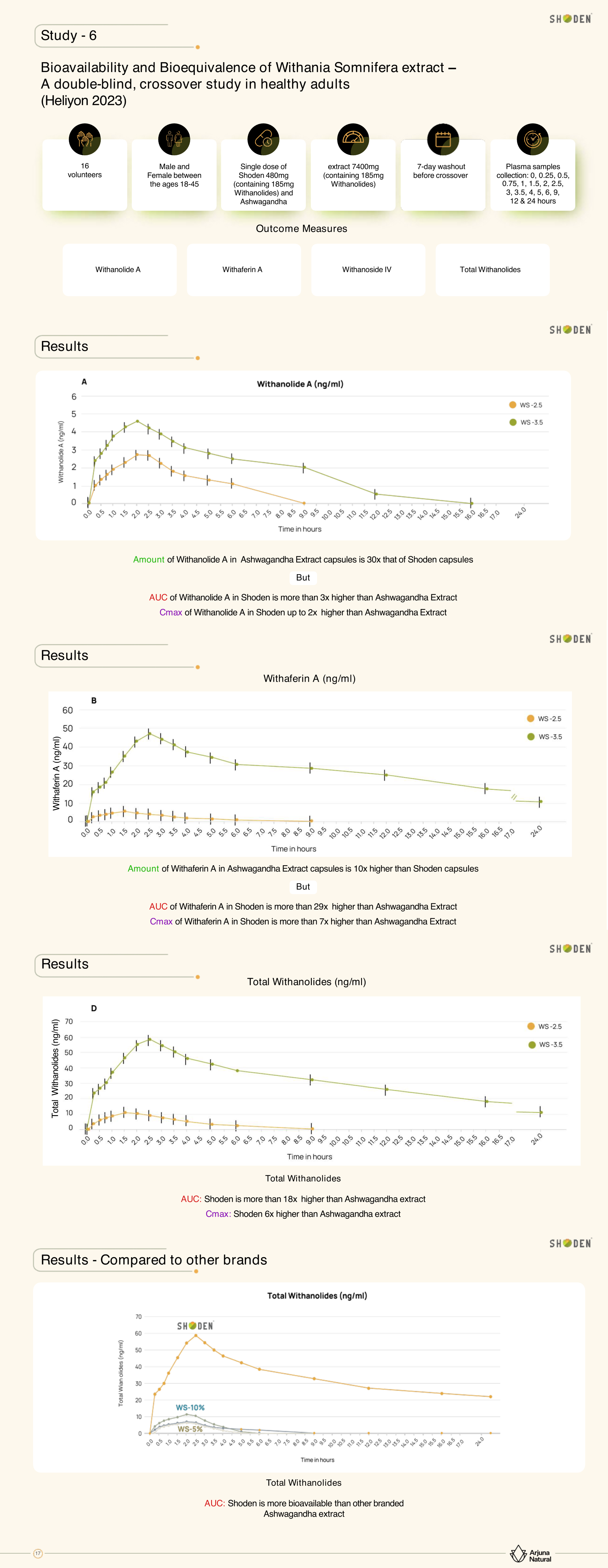
Comprehensive analysis from the 2023 Heliyon study comparing the bioavailability of Shoden versus traditional ashwagandha extract, demonstrating superior absorption and bioavailability of withanolides through detailed pharmacokinetic measurements over 24 hours.[2]
For our regular readers, this is similar to what we frequently discuss with dihydroberberine and berberine -- dihydroberberine has better uptake than berberine itself, yet converts back to berberine, leaving you with more actual berberine at the end, despite a lower starting dose. The same goes for withanolide aglycones compared to forms without the glycoside attachment.
By utilizing this glucose transport mechanism, Shoden's standardization to 35% withanolide glycosides allows for greater effectiveness at lower doses. The extract's potency is verified through high-performance liquid chromatography (HPLC) testing, ensuring consistent levels of these beneficial compounds.[2]
Clinical Research on Shoden
The efficacy of Shoden has been validated through several well-designed clinical trials investigating its effects on various aspects of human health and performance. Let's explore the research, starting with what makes this extract unique from a bioavailability perspective:
-
Bioavailability Research (Kim 2023)
Discussed in the section above, in a randomized, double-blind crossover study published in 2023, researchers compared the bioavailability of Shoden to a standard ashwagandha extract.[2] Both extracts delivered the same amount of total withanolides (185mg), but required vastly different doses to achieve this – 480mg of Shoden versus 7400mg of the standard extract!
These results are striking: Despite using significantly less material, Shoden demonstrated superior absorption metrics across several key parameters:[2]
- Shoden's total withanolides was 18 times higher per the area under curve (AUC)
- Shoden's maximum concentration (Cmax) reached levels 6 times higher than the standard extract
- Shoden had 4.13 times longer mean residence time
These findings help explain why Shoden can achieve significant effects at lower doses compared to traditional ashwagandha preparations. As discussed above, the enhanced bioavailability is attributed to its high concentration of withanolide glycosides, which appear to be better absorbed than their aglycone counterparts.[2]
-
Male Vitality Study (Lopresti 2019a)
In an innovative 2019 study, researchers examined Shoden's effects on hormones and vitality in aging, overweight men. This 8-week crossover trial used the same 240mg daily dose (delivering 21mg withanolide glycosides) in men aged 40-70 years reporting mild fatigue.[20]
Results from the 2019 crossover study demonstrating Shoden's impact on testosterone and DHEA-S levels in overweight males, showing significant increases of 14.7% in testosterone compared to placebo.[20]
Results showed that compared to placebo, Shoden supplementation led to:[20]
- 14.7% higher testosterone levels
- 18% higher DHEA-S levels
While there were improvements in measures of fatigue and vigor, these changes weren't statistically significant compared to placebo. However, the hormonal improvements suggest Shoden may help support healthy testosterone levels in aging males.[20]
-
Stress & Anxiety Study (Lopresti 2019b)
In another innovative 8-week, randomized, double-blind, placebo-controlled study published in 2019, researchers investigated Shoden's effects on adults with moderate anxiety.[9] The study used a conservative dose of ashwagandha - just 240mg delivering 84mg of withanolide glycosides.
Comprehensive analysis of stress markers from the 2019 Medicine study, showing significant reductions in HAM-A scores and cortisol levels with 240mg daily Shoden supplementation.[9]
Compared to placebo, the Shoden group showed significant:[9]
- Greater reduction in anxiety scores measured by the Hamilton Anxiety Rating Scale (HAM-A)
- Greater reduction in morning serum cortisol levels
- Greater reduction in DHEA-S levels, a marker of reduced HPA (hypothalamic-pituitary-adrenal) axis activity associated with stress
This study showed that using even modest doses of Shoden could effectively modulate stress hormones and reduce anxiety symptoms.
-
Sleep Study (Deshpande 2020)
In a randomized, double-blind, placebo-controlled study published in 2020, researchers investigated the effects of Shoden in healthy adults with non-restorative sleep. This landmark study used sophisticated sleep actigraphy to measure outcomes in 150 participants.[15]
Just 120mg of Shoden daily for 6 weeks led to a remarkable 72% improvement in self-reported sleep quality – more than twice the improvement seen in the placebo group.[15]
The study revealed significant improvements across multiple sleep parameters:[15]
- Increased sleep efficiency
- Reduced sleep onset latency (time to fall asleep)
- Improved total sleep time
- Decreased wake time after sleep onset
What's more impressive is that these sleep benefits generally occurred without the typical side effects associated with some medications -- it didn't cause morning grogginess or dependency. In fact, study participants often reported feeling more mentally alert upon waking.[15]
This marks a significant advance over traditional ashwagandha preparations, which typically require much higher doses to achieve similar benefits.
-
Immunomodulatory Study (Tharakan 2021)
In a groundbreaking study published in 2021, researchers examined the immune-boosting capabilities of Shoden in healthy adults. This double-blind, placebo-controlled trial consisted of a 30-day blinded period followed by a 30-day open-label extension where placebo subjects crossed over to receive Shoden.[36]
Data visualization from the 2021 clinical trial showing Shoden's effects on immunoglobulins, cytokines, and TBNK cell counts in healthy participants over a 60-day period.[36]
The results showed significant improvements in multiple aspects of immune function. After just 30 days, participants taking 60mg of Shoden daily showed significant increases in:[36]
- Immunoglobulins (IgA, IgM, IgG, IgG2, IgG3, and IgG4)
- Key cytokines (IFN-γ, IL4)
- TBNK cells (CD45+, CD3+, CD4+, CD8+, CD19+, NK cells)
During the 30-day extension period, subjects who switched from placebo to Shoden showed similar improvements in immune markers. Meanwhile, participants who continued taking Shoden demonstrated further significant improvements in these immune parameters.[36]
The study demonstrated Shoden's ability to enhance both innate and adaptive immunity by modulating multiple immune system components. This balanced immune support occurred without any reported adverse effects, suggesting Shoden could be valuable for maintaining healthy immune function.[36]
-
Stress Study - Follow Up (Mishra 2024)
In a 2024 study, a lower dose of Shoden (just 60mg daily) showed impressive effects on anxiety and stress symptoms. Researchers conducted a randomized, placebo-controlled trial in healthy subjects experiencing high stress levels.[14]
Results from the 2024 Heliyon study showing dose-dependent effects of Shoden on cortisol reduction and testosterone enhancement in stressed individuals over 60 days.[14]
After 60 days, the research team found remarkable improvements in multiple stress-related parameters:[14]
- Hamilton Anxiety Rating Scale (HAM-A) scores decreased by 59% in both 60mg and 120mg Shoden groups (compared to a negligible increase in placebo)
- Morning serum cortisol levels dropped by 66% and 67% in the 60mg and 120mg groups respectively
- In males, testosterone levels increased by 22% and 33% in the 60mg and 120mg groups
- Perceived Stress Scale scores decreased by 53% and 62% in the 60mg and 120mg groups
The study also tracked Clinical Global Impression scores, which showed reductions of 72% and 68% in the 60mg and 120mg groups, indicating significant improvements in overall wellbeing.
What's incredible about this research is how effective the lower 60mg dose was - demonstrating that Shoden's enhanced bioavailability allows for meaningful benefits at conservative dosages.[14]
-
Safety Profile: Low Doses, Low Adverse Events
Across these clinical studies examining Shoden, researchers consistently reported excellent safety and tolerability.
- In the sleep study with 150 participants using 120mg daily, no serious adverse effects were reported, and there were no dropouts due to adverse events.[14]
- The immune health trial using 60mg daily reported no adverse events during either the blinded or open-label extension periods.[36]
- In the stress and anxiety studies using doses ranging from 60mg to 240mg daily, researchers found no significant adverse events, with blood chemistry and safety parameters remaining within normal ranges.[9,14]
- Coming Soon: In a safety study on 62 healthy participants who were administered 480mg Shoden once daily for 3 months, hematology parameters, lipid profile, liver functioning test, renal parameters, urine tests and vitals were analyzed. Study results showed Shoden was safe for intake up to this high dose of 480mg.
This study is under peer review for publication
A detailed presentation of Shoden's testosterone-supporting clinical evidence, featuring three key studies showing testosterone increases of 14%, 12%, and 33% respectively. The image highlights Shoden's selective effects on male hormonal health while emphasizing its broader adaptogenic benefits for stress, sleep, and immune support.
This consistent safety profile across multiple studies, doses, and durations suggests that Shoden is well-tolerated when used as directed.[1] The fact that these benefits were achieved at relatively low doses compared to traditional ashwagandha extracts may further support its safety profile.
Shoden vs. Shoden-R
While the original Shoden extract combines both ashwagandha root and leaf material to provide a complete spectrum of beneficial compounds, Arjuna Natural is expanding their lineup with Shoden-R - a root-only extract standardized to the same 35% glycowithanolides. This innovative formulation maintains the potent standardization of the original while offering improved taste and stability profiles, making it ideal for ready-to-mix (RTM) powder applications, ready-to-drink (RTD) beverages, shots, and other liquid applications.
Shoden-R: For Powder and Beverage / RTD Applications
The key difference lies in the removal of leaf material, which contributes to the characteristic bitterness of traditional ashwagandha extracts. While leaves are naturally richer in flavonoids, Shoden-R achieves the same 35% glycowithanolide content through an optimized extraction process focused solely on root material.
The result is a clear, virtually zero-opacity extract that maintains similar chromatographic fingerprints with adjusted peak distributions. Arjuna Natural is currently conducting clinical research comparing Shoden-R against the original root and leaf combination, specifically examining stress responses in women.
Sign up for PricePlow's Shoden news alerts at the top and bottom of this article to stay informed about this exciting development and future innovations from Arjuna Natural. We'll keep you updated on the clinical trial results and product launches as they become available.
Dosage and Timing
Ashwagandha dosage varies significantly depending on the extract used and its standardization. Based on the research available, doses vary significantly from 60mg and 1000mg per day. Again, the optimal dosage will greatly depend on the standardization and extract type.

Overview of Shoden's available formulations, featuring the powder form for encapsulation and the recommended daily dosage range of 60-120mg for healthy adults.
For Shoden specifically, research shows significant stress-reducing and hormone-balancing effects at the following doses:
- 60mg daily: Demonstrated improvements in anxiety markers and stress response[14]
- 120mg daily: Provided significant sleep quality improvements and stress reduction[15]
- 240mg daily: Shown to reduce cortisol levels and improve stress markers and testosterone levels[9]
Working with Shoden leads to far greater flexibility, both in terms of capsule size but also taste. The flexibility gets even better in terms of timing:
Shoden: One dose per day!
Additionally, most Ashwagandha supplements need to be taken twice daily. Shoden is demonstrated to be a single-dose supplement!
As mentioned throughout this article, Shoden's key advantage is its ability to deliver clinical benefits at lower doses compared to traditional ashwagandha extracts, thanks to its high standardization of withanolide glycosides at 35%.[2]
For optimal results, daily dosing is recommended rather than intermittent use. Most studies demonstrate benefits when taking the supplement consistently for 8-12 weeks.[6]
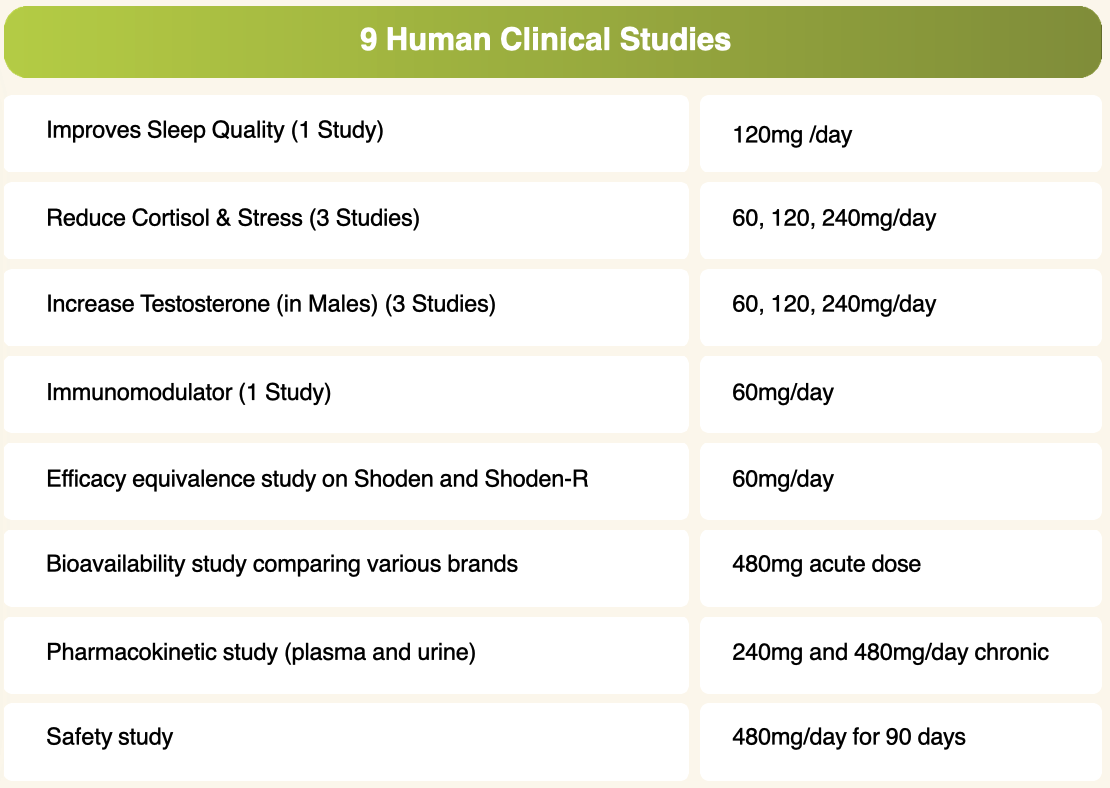
Summary of nine human clinical trials conducted on Shoden ashwagandha extract, highlighting the diversity of benefits studied and their corresponding dosage ranges, from 60mg to 480mg daily across sleep, stress, hormonal, immune, and safety studies.
While ashwagandha can be taken any time of day, many people prefer taking it in the evening, especially when using it to support sleep quality. For Shoden specifically, we recommend:
- For sleep & relaxation: Take 120mg 2 hours before bedtime
- For healthy testosterone in males: Take 60-120mg in the morning after breakfast
- For daytime stress support: Take 60-120mg in the morning after breakfast
- For adaptogenic benefits: Split into two daily doses of 60mg each
Ashwagandha can be part of numerous healthy diet and supplement regimes -- it can be stacked with many other ingredients, but is definitely worth trying on its own. Below are some great Shoden-based supplements to consider:
Conclusion: The Next Chapter in Ashwagandha’s Story
The evolution of ashwagandha from traditional Ayurvedic medicine to modern, standardized extracts represents a significant advancement in natural supplementation.
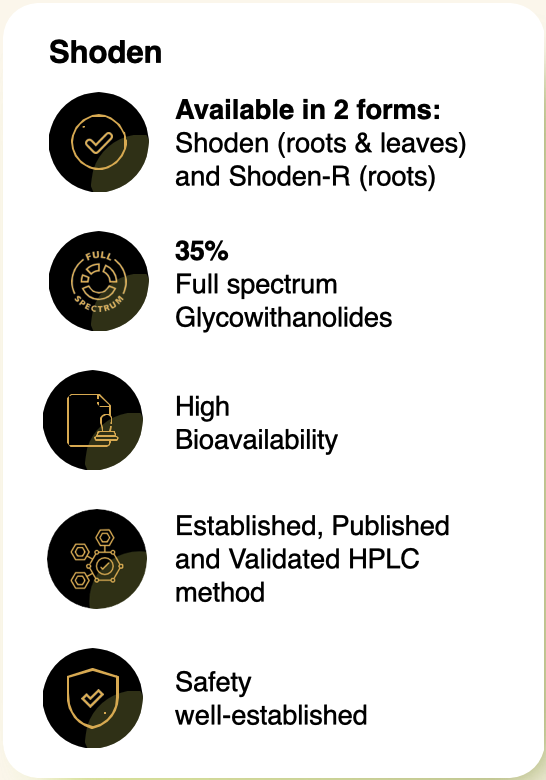
A visual breakdown of Shoden's five core features, highlighting its dual-form availability, 35% glycowithanolide standardization, enhanced bioavailability, validated HPLC testing method, and established safety profile.
With Shoden's industry-leading standardization to 35% withanolide glycosides, we're seeing unprecedented bioavailability and efficacy at remarkably low doses compared to traditional extracts. And it's only going to get better with the beverage-ready Shoden-R.
The research demonstrates that ashwagandha delivers powerful benefits across multiple domains - from stress and anxiety reduction to testosterone support, sleep quality improvement, and cognitive enhancement. By focusing on the more bioavailable glycoside form of withanolides, Shoden has managed to achieve significant effects at doses as low as 60mg daily - a fraction of what's typically required with conventional ashwagandha extracts.
What makes this extract truly remarkable is the herb's comprehensive approach to wellness. Rather than targeting just one aspect of health, ashwagandha appears to work through multiple pathways to help optimize both physical and mental performance. Shoden's excellent safety profile, growing body of clinical research, and lower dose make it a compelling choice for anyone looking to enhance their overall wellbeing.
Through the combination of ancient wisdom and modern science, Shoden represents not just an improvement in ashwagandha supplementation, but potentially a new standard for what we should expect from botanical extracts.
If you're interested in experiencing the benefits of this next-generation ashwagandha extract, check out the supplements listed above. To stay updated on new Shoden products and the latest research from Arjuna Natural, sign up for PricePlow's Shoden and Arjuna Natural alerts using the form at the bottom of this article.
The future of adaptogenic herbs looks bright, and Arjuna Natural is leading the way with Shoden.
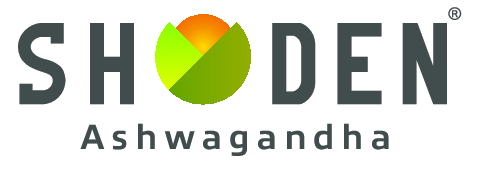
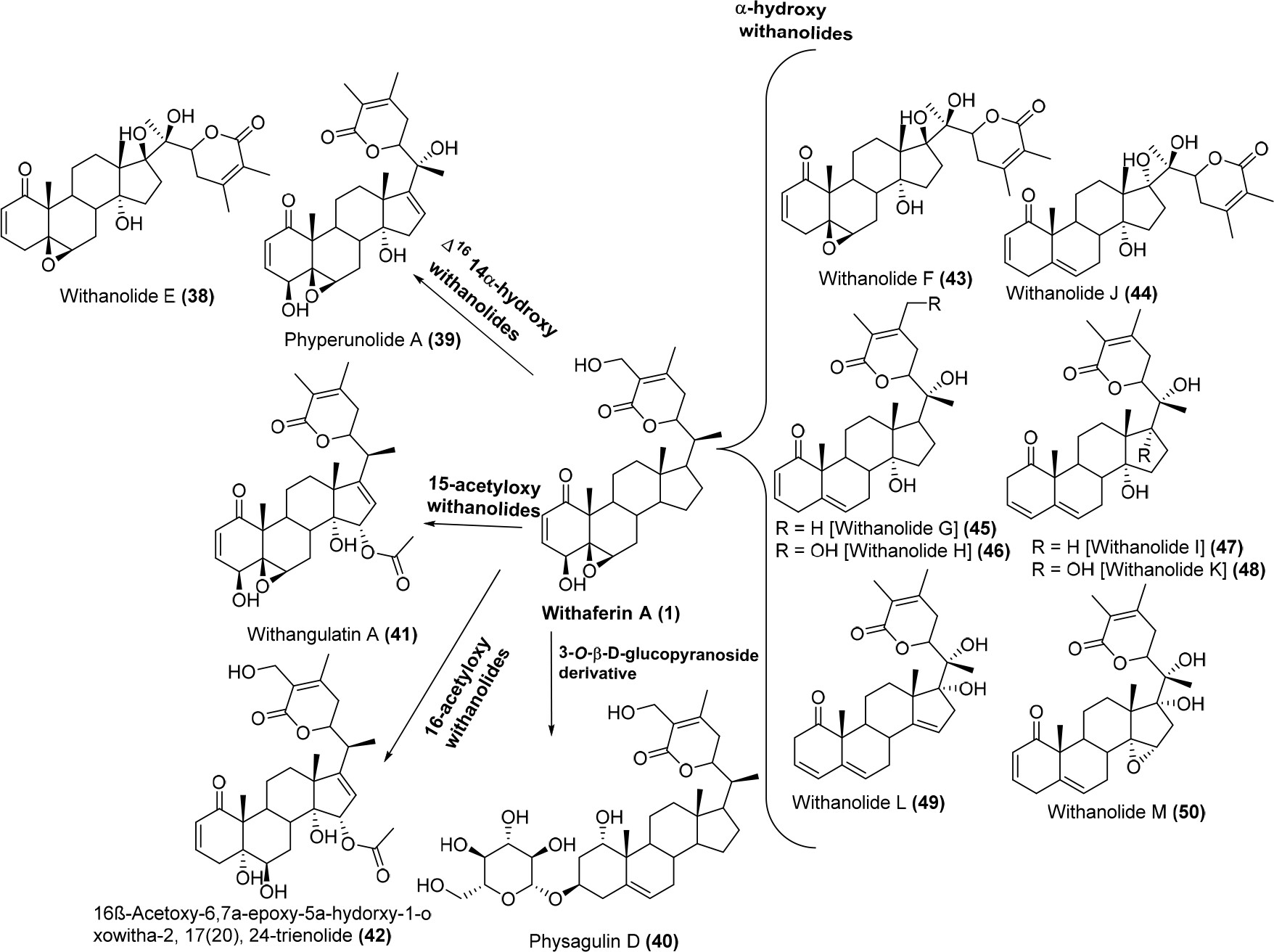
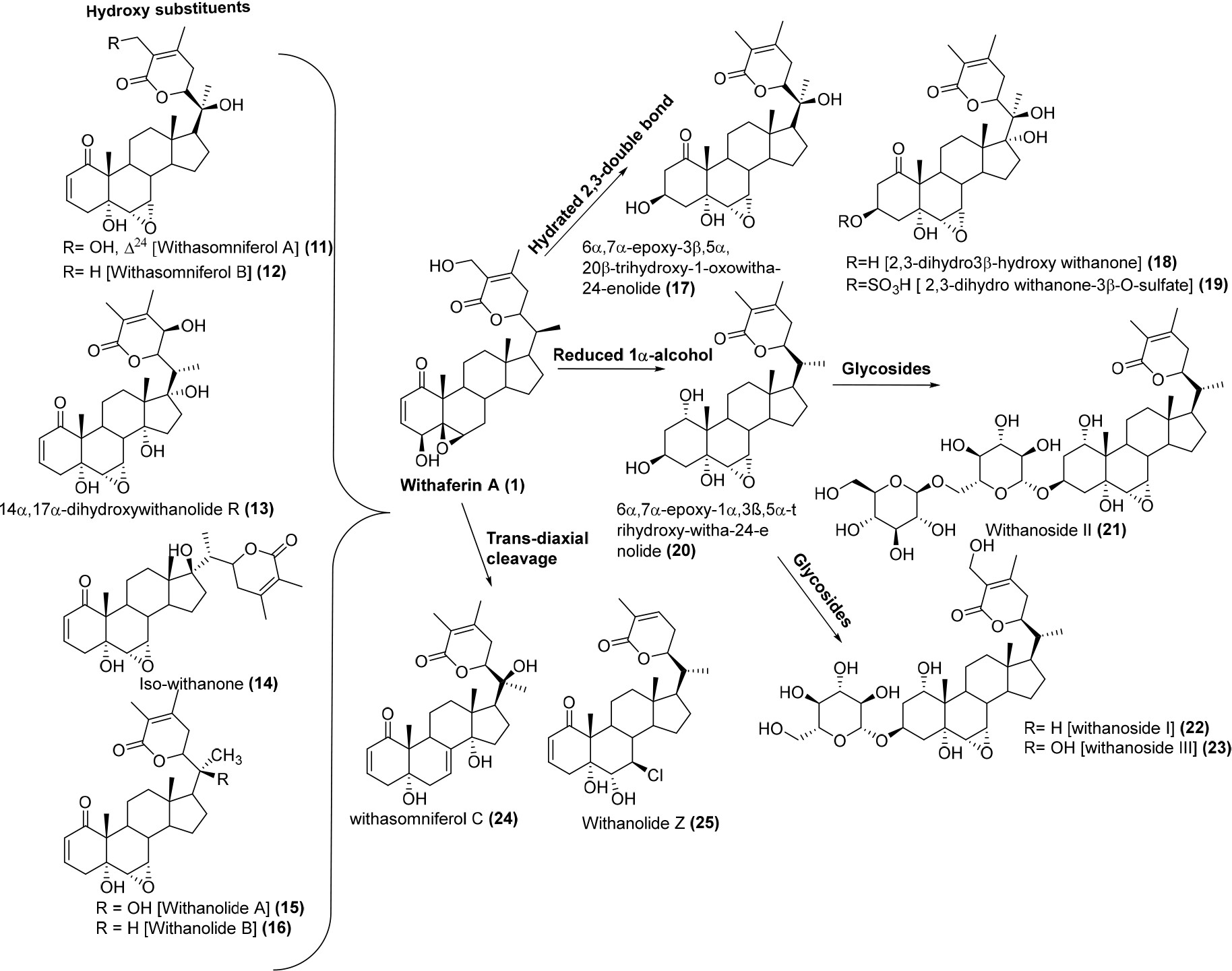
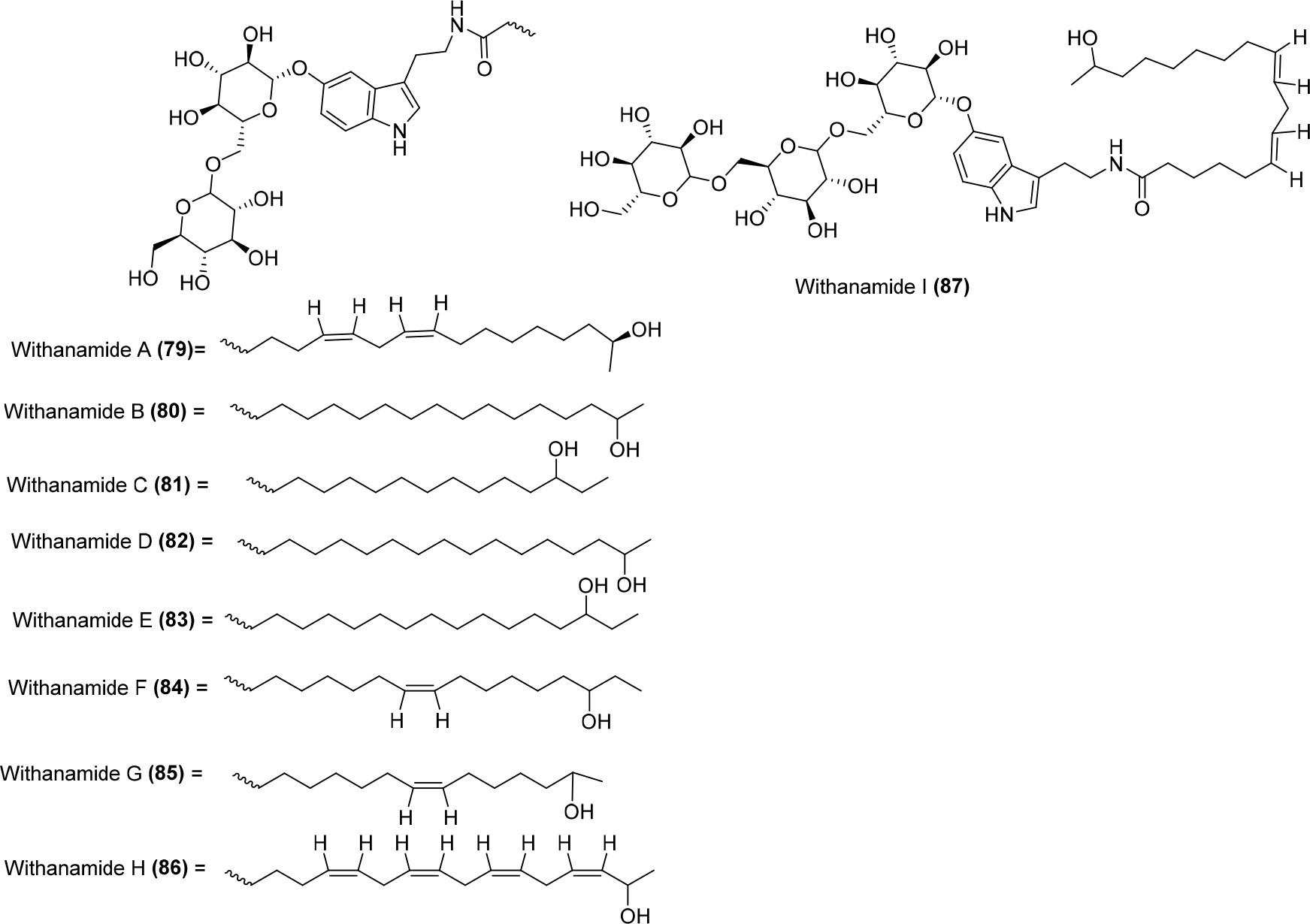
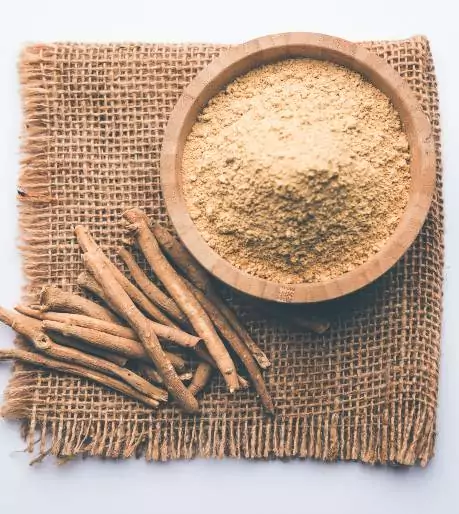
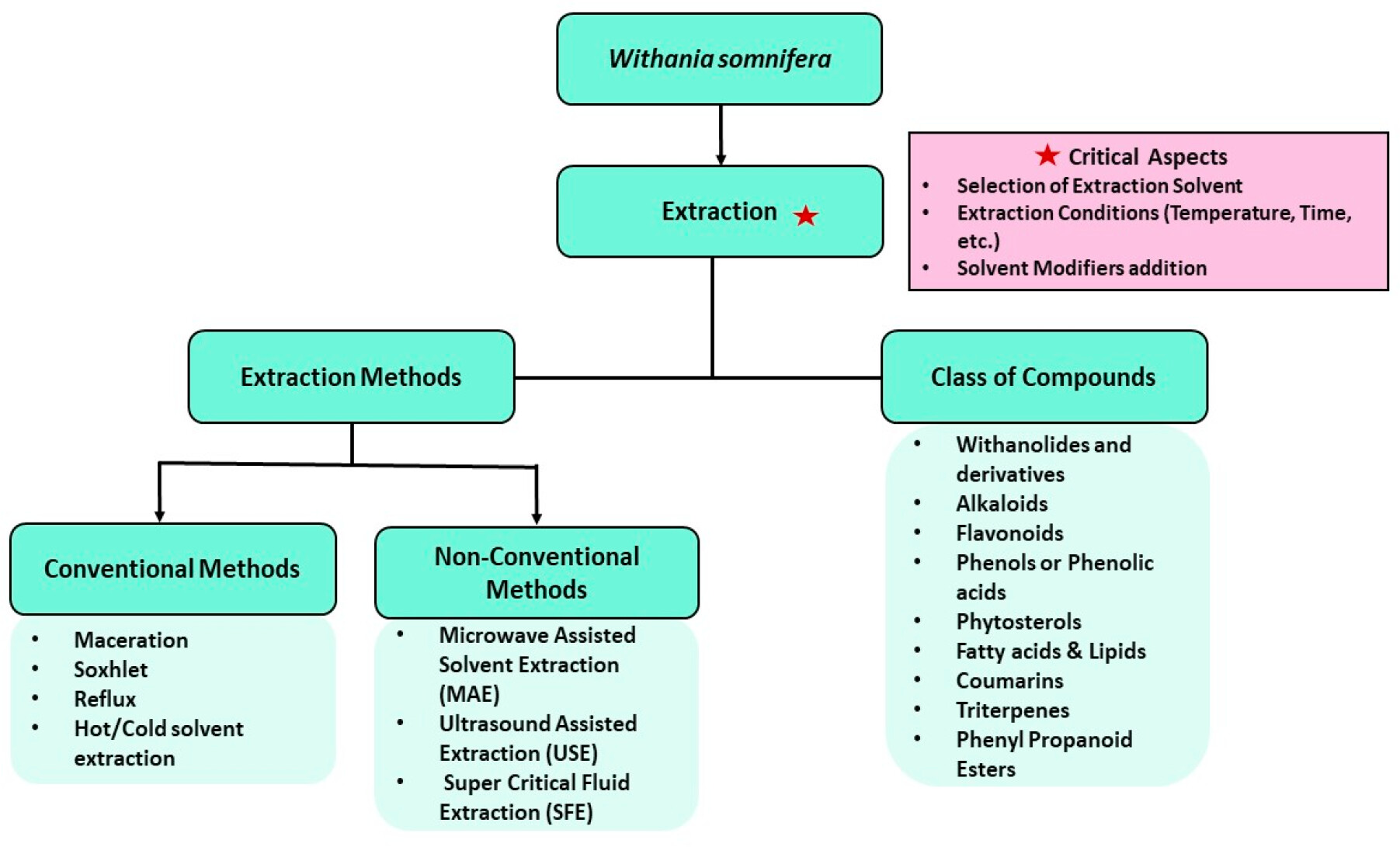

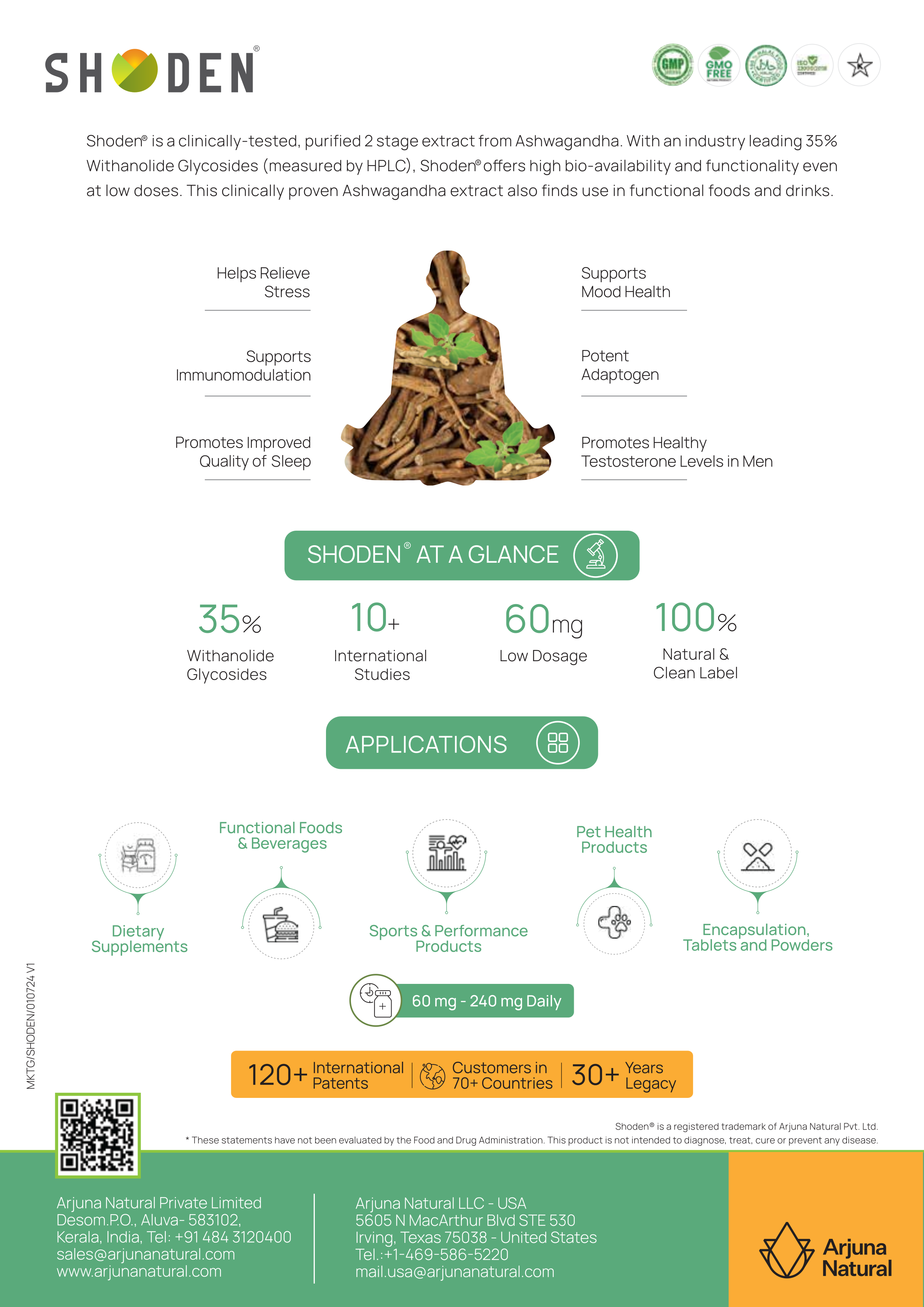
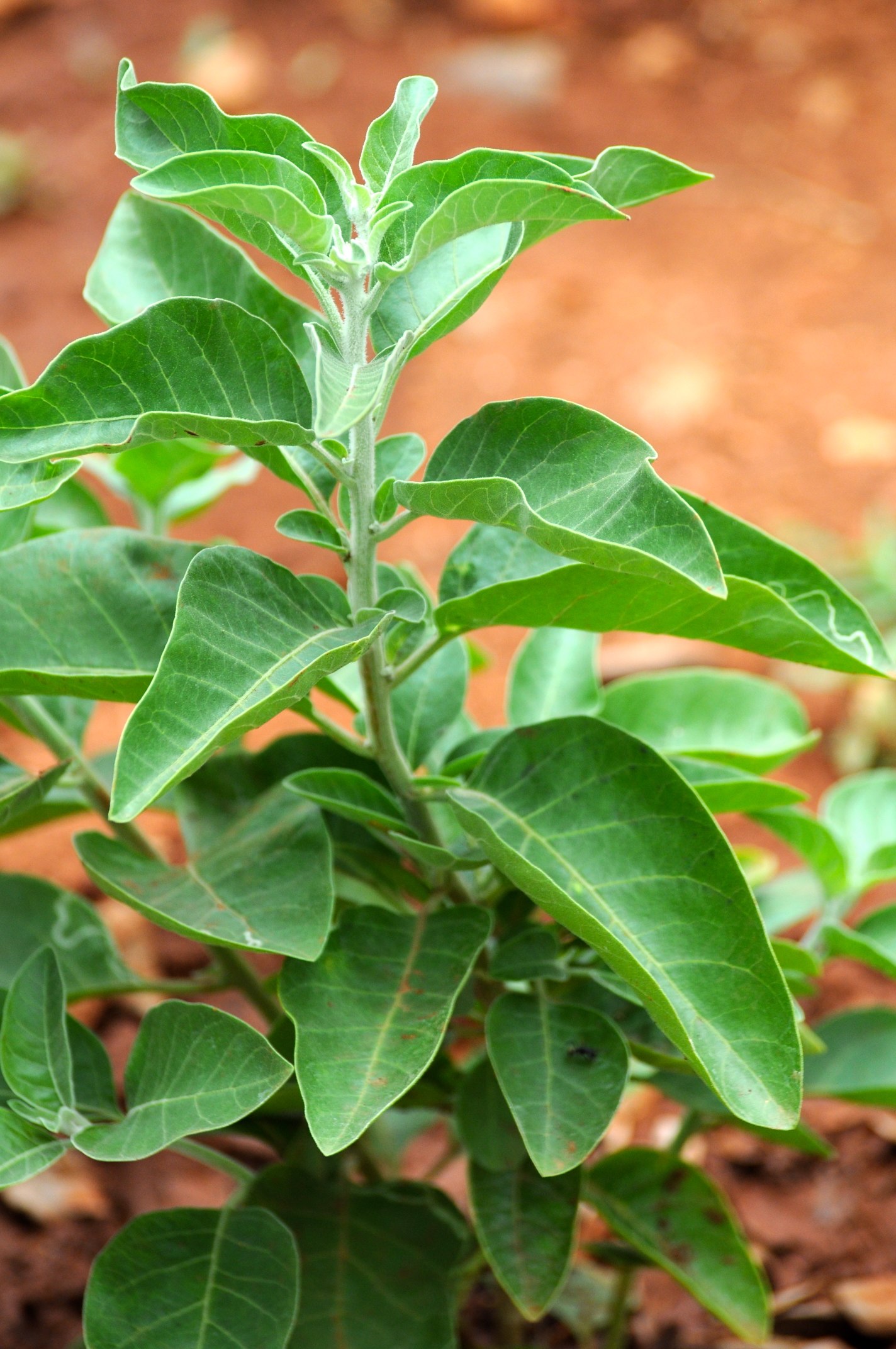
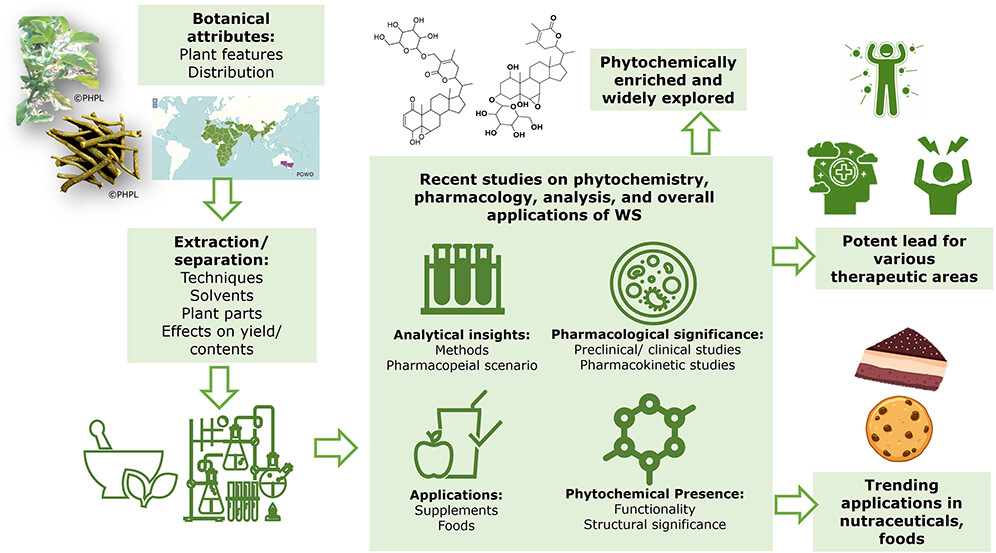
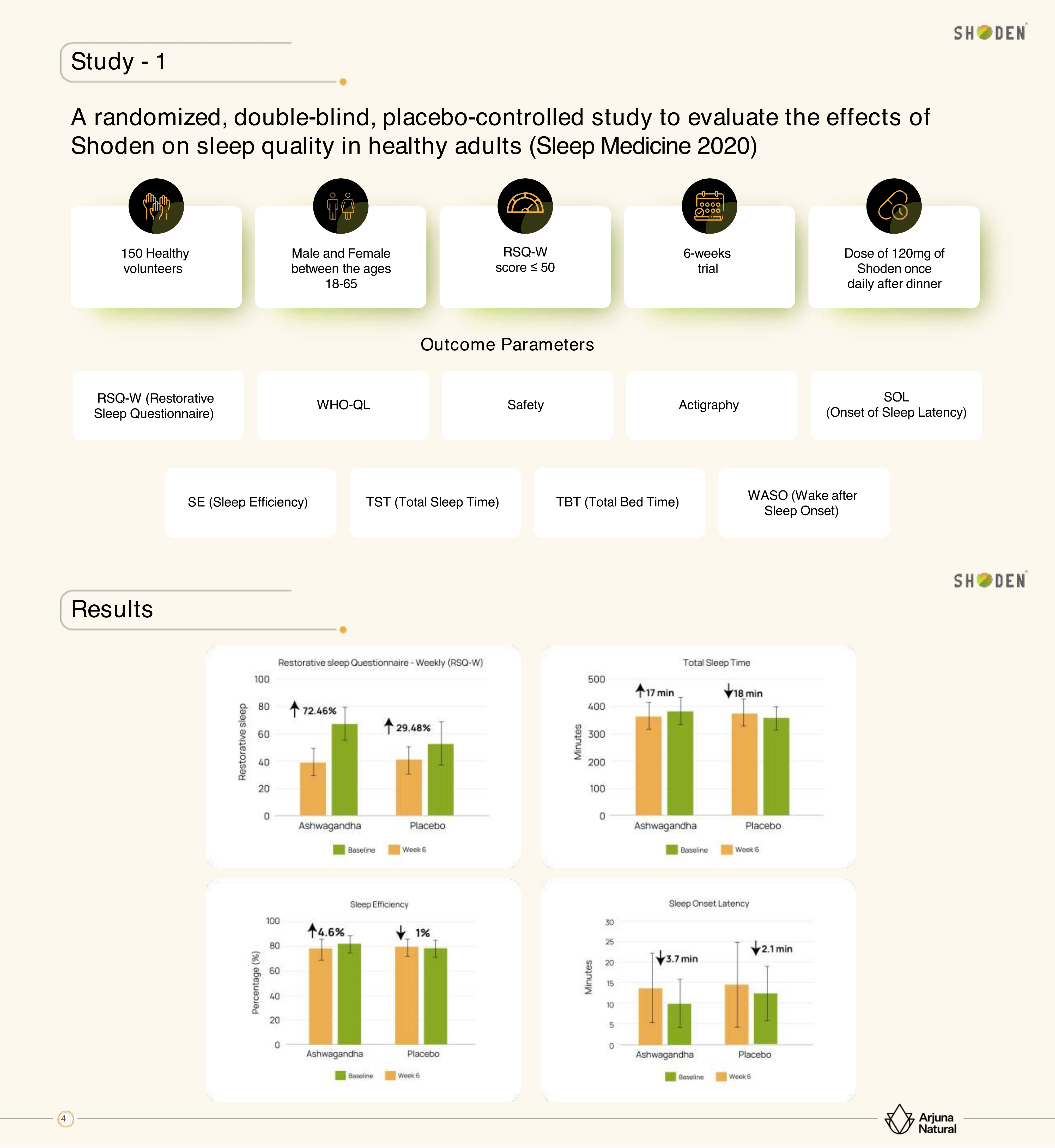
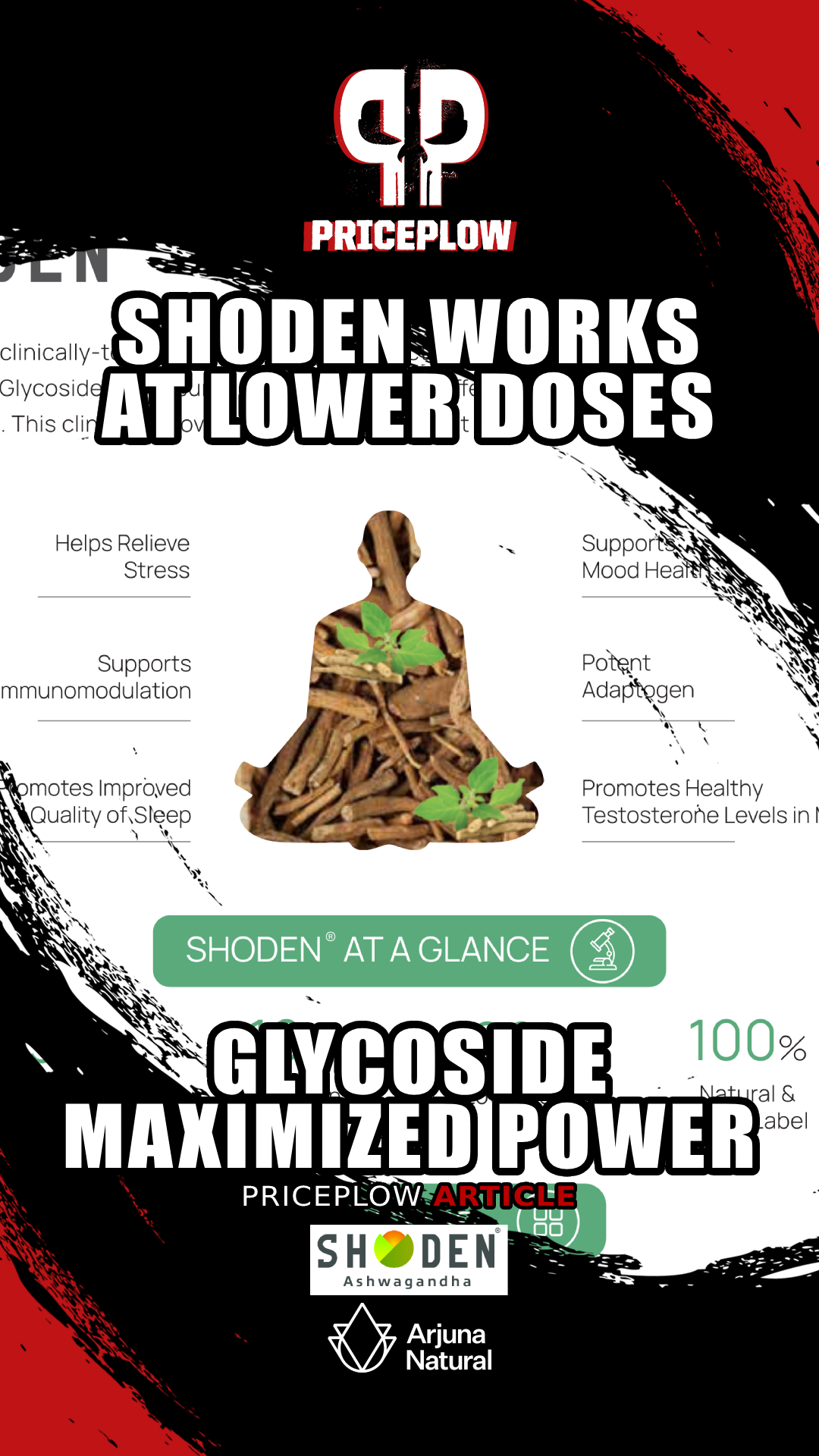


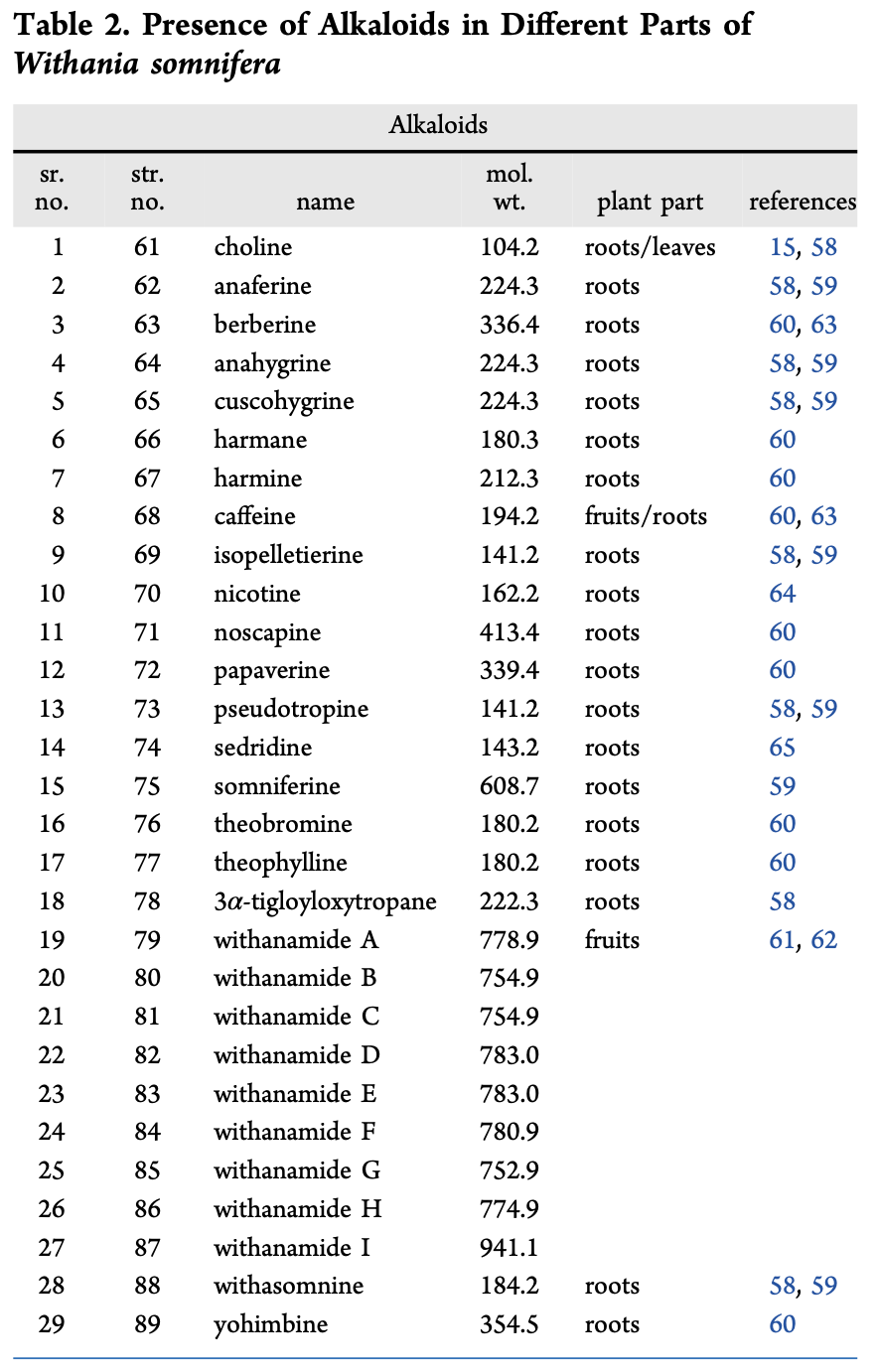
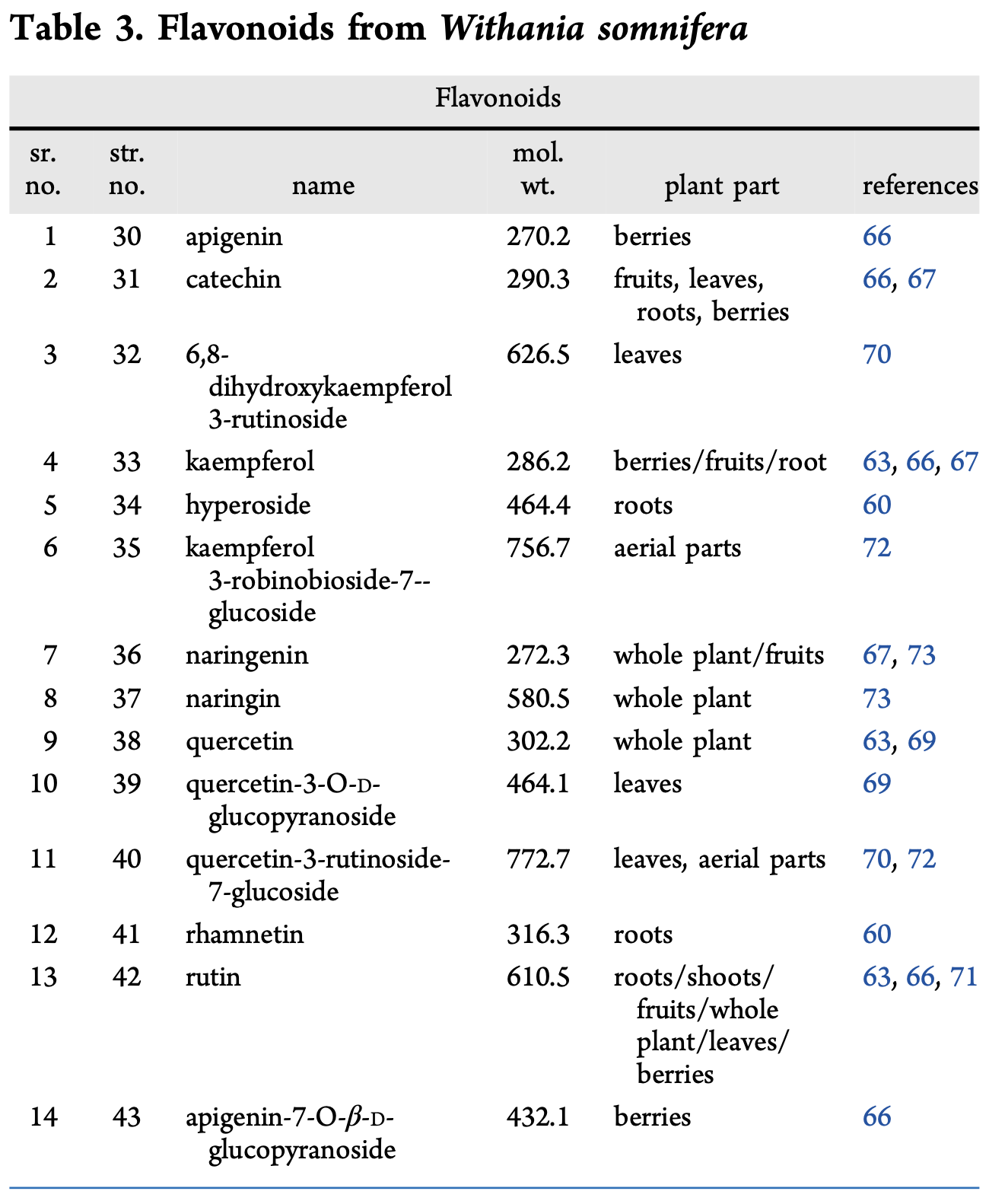
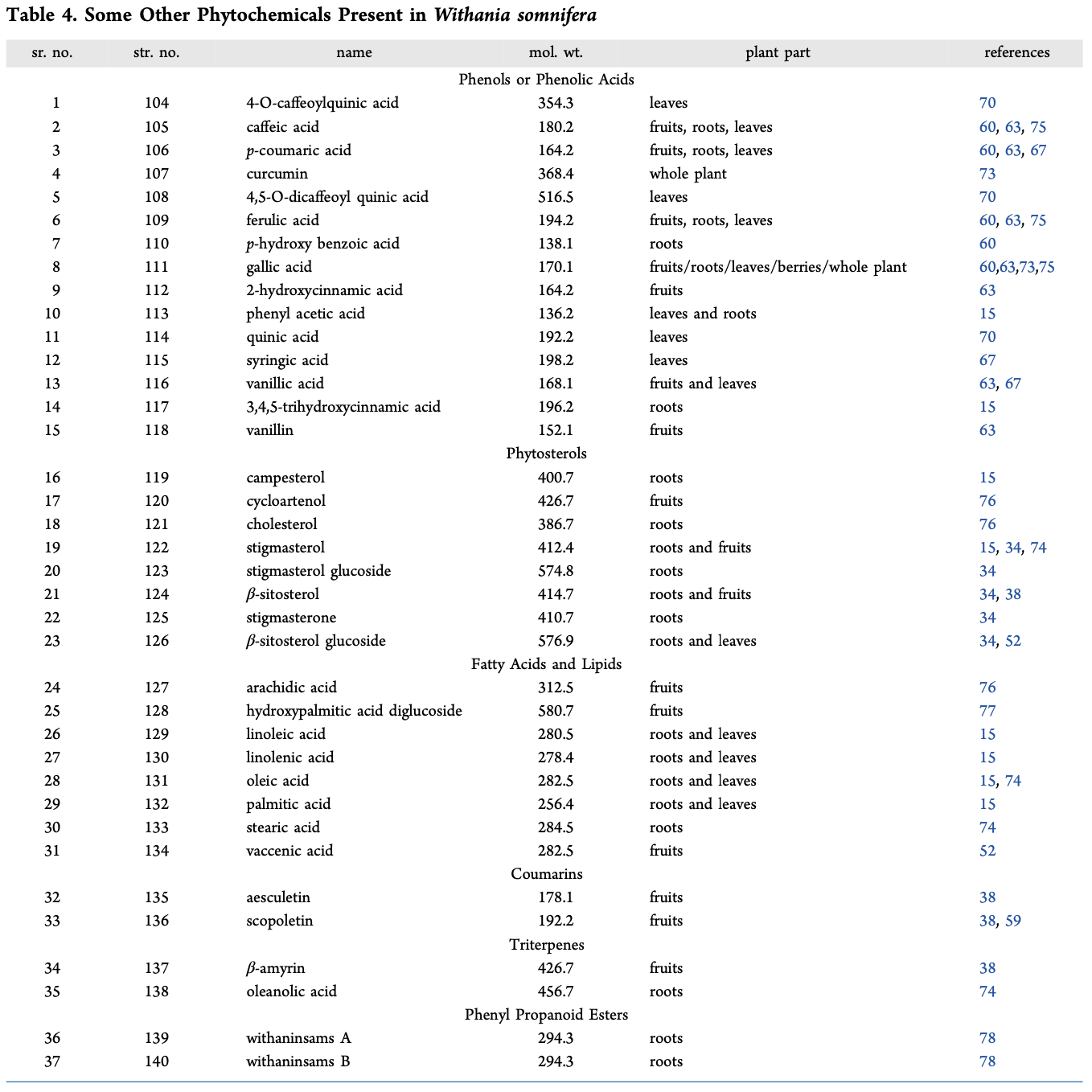


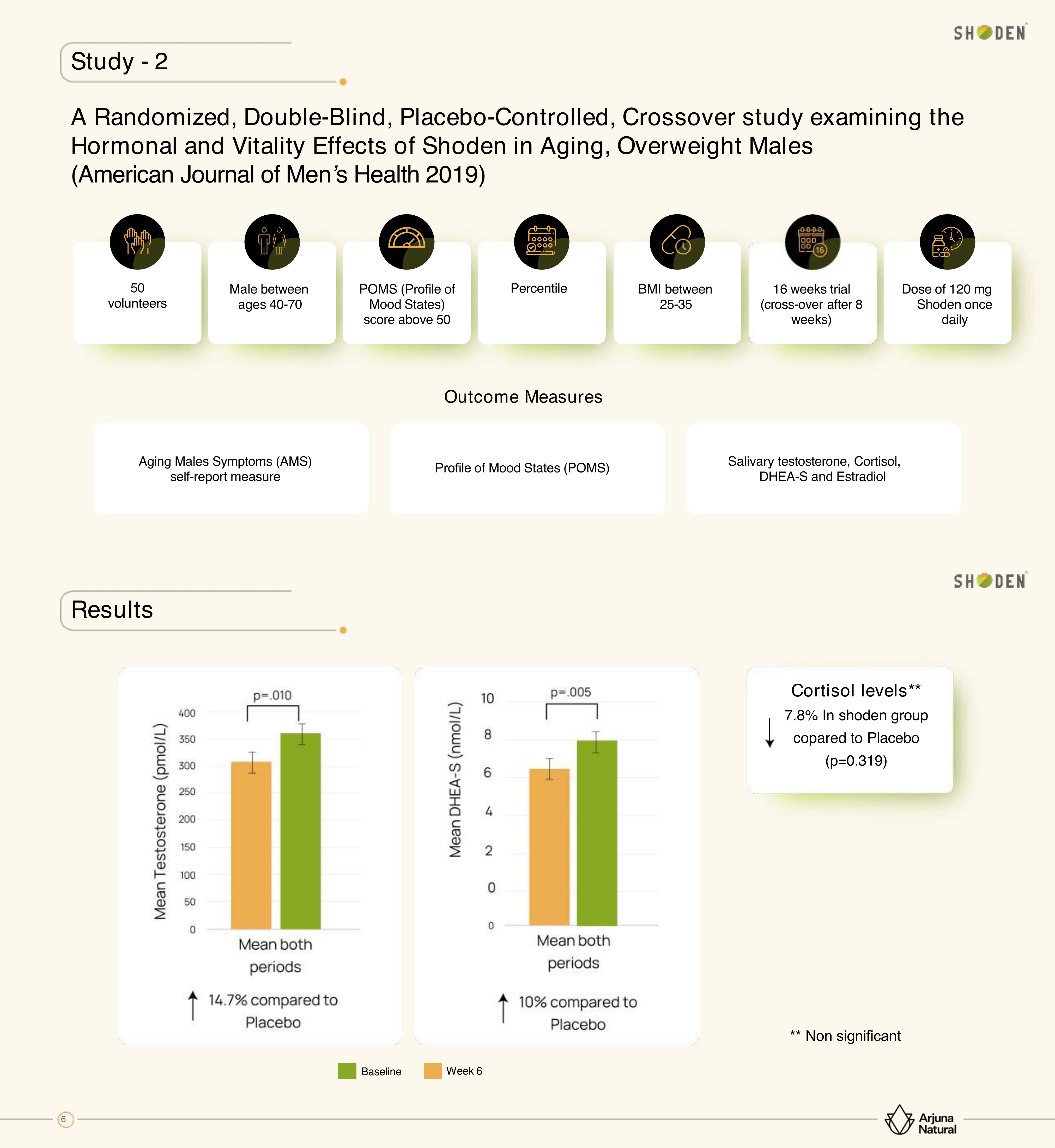
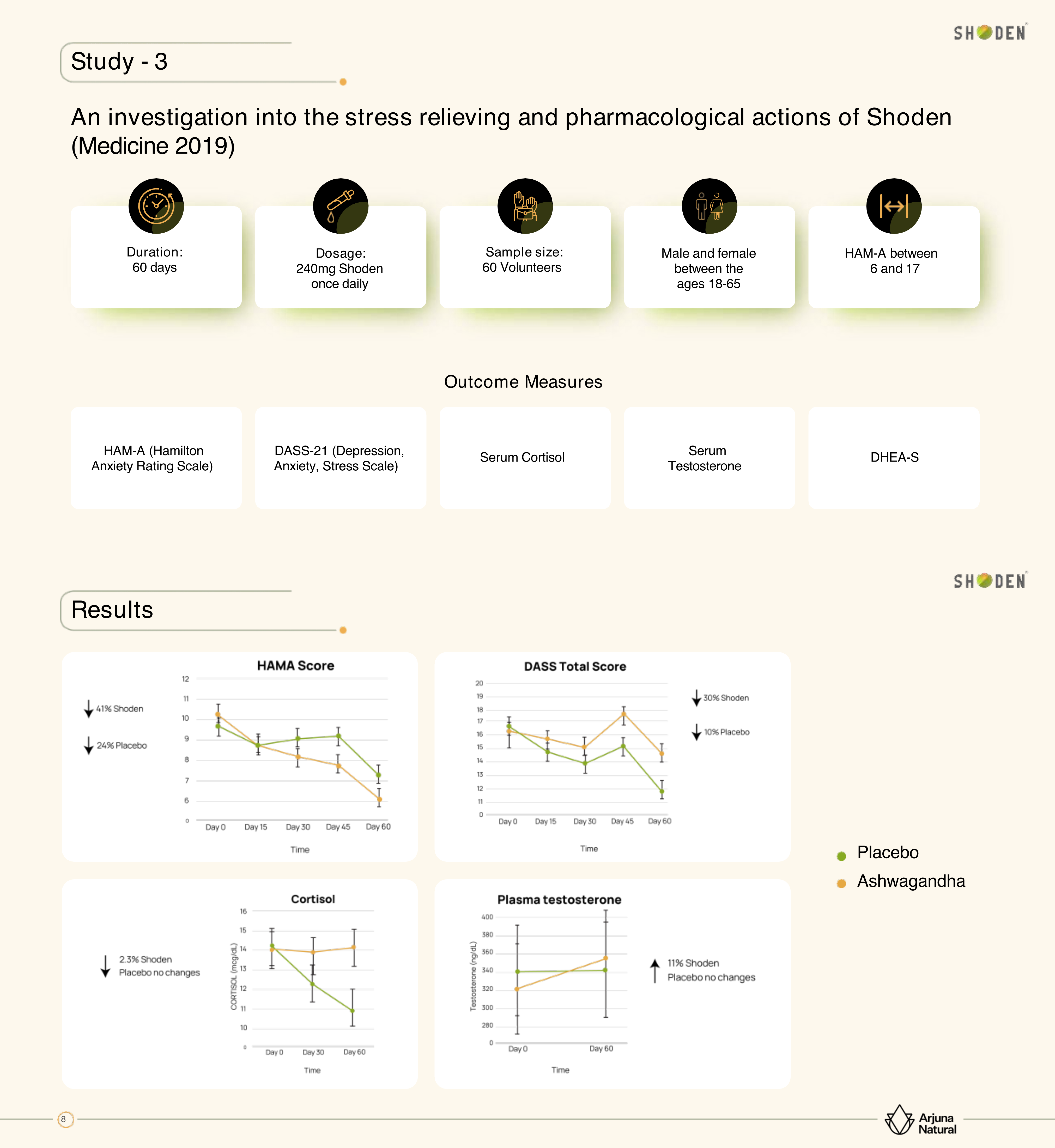
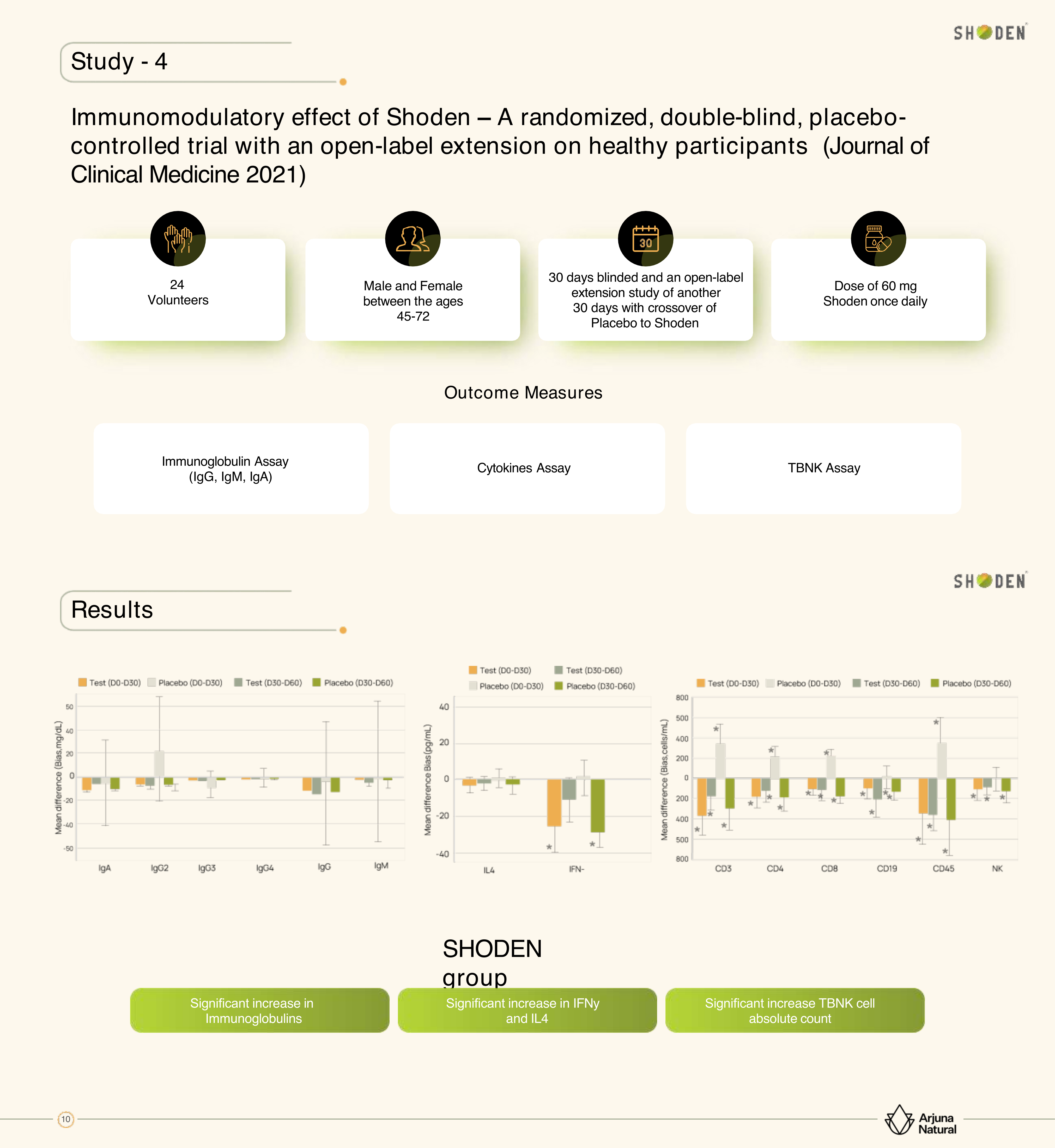
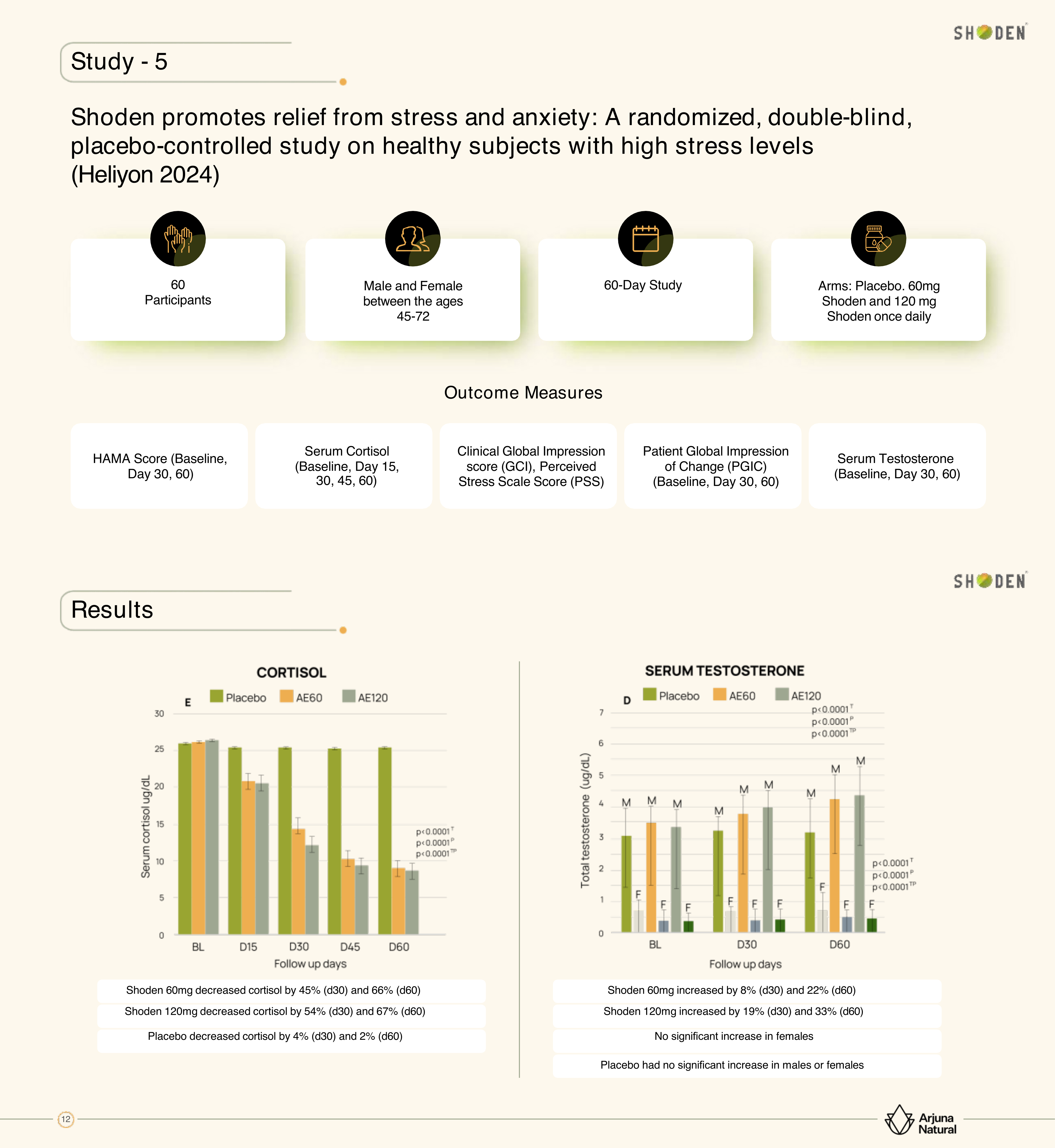
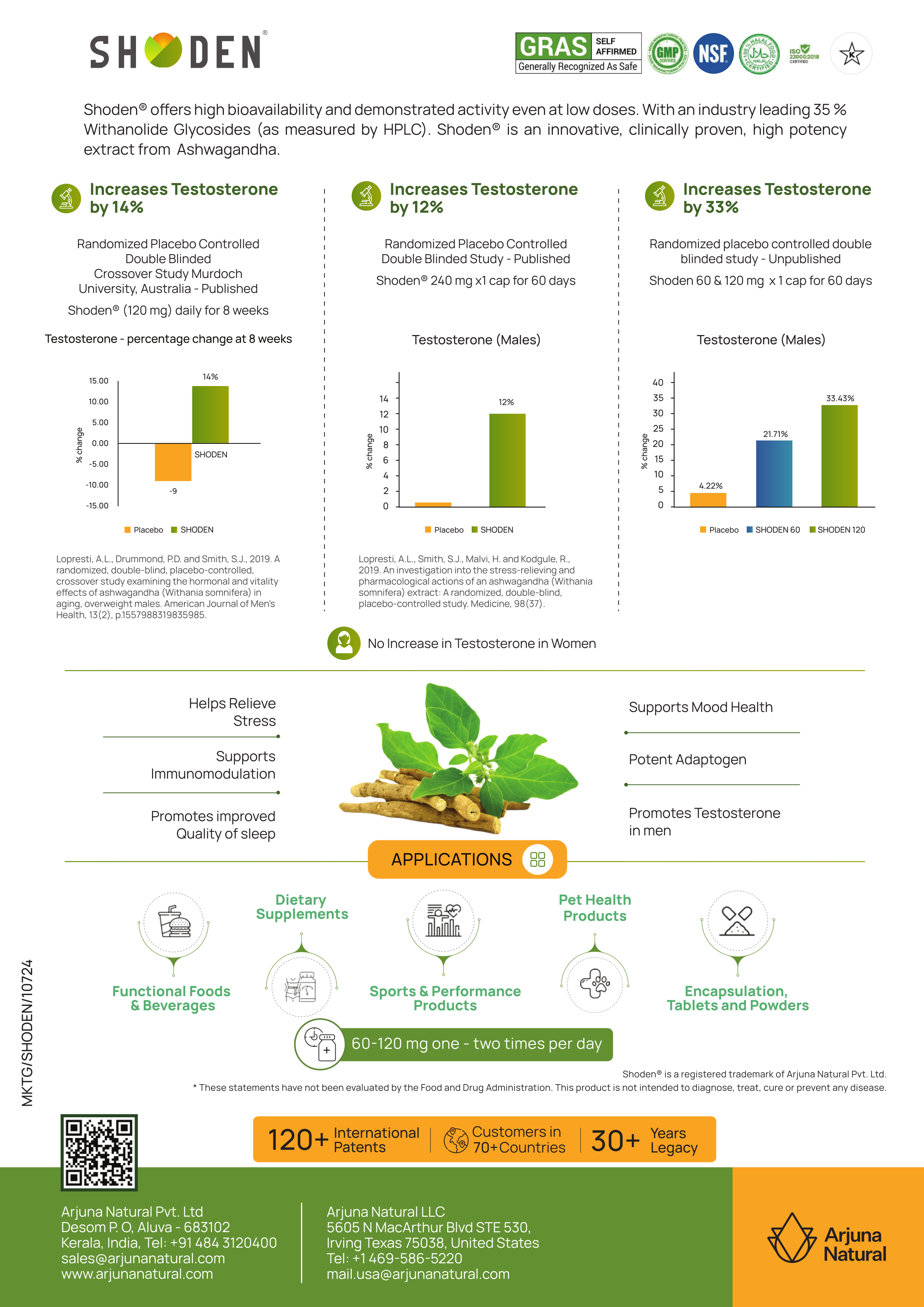
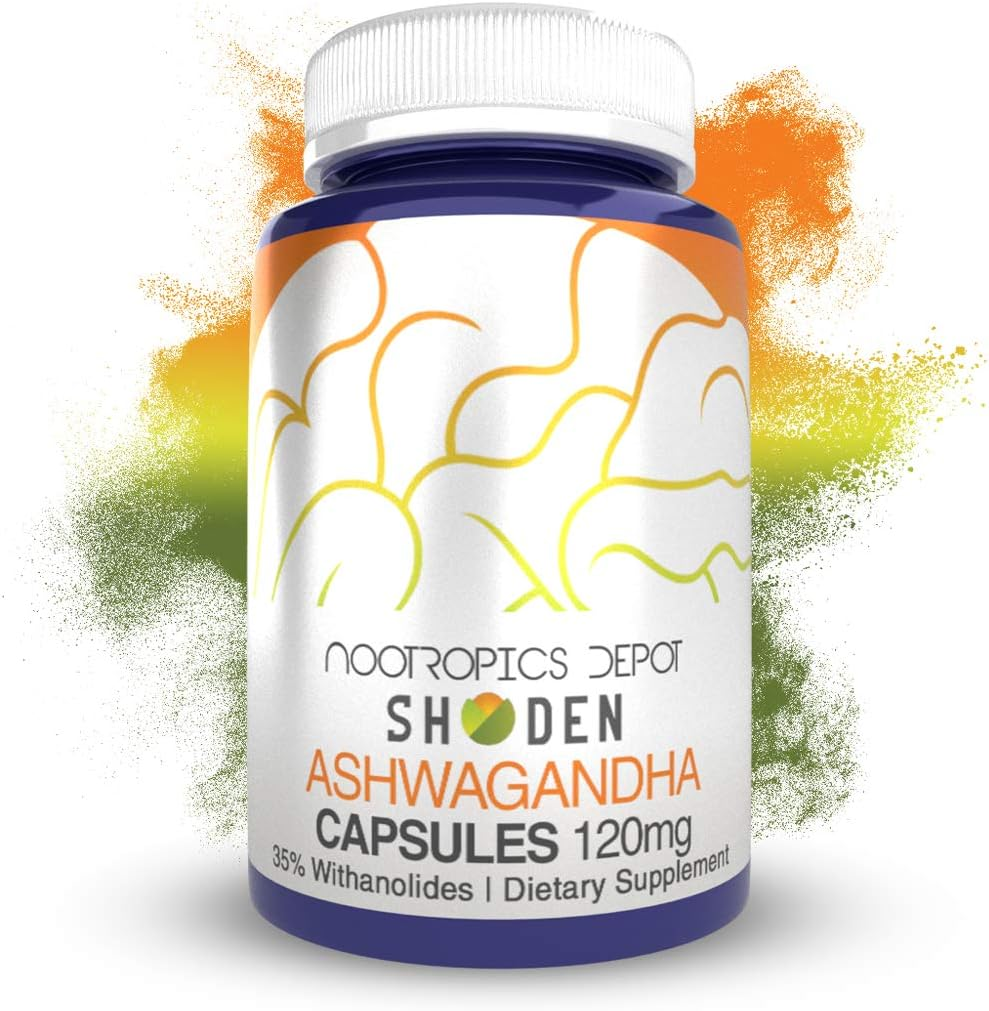
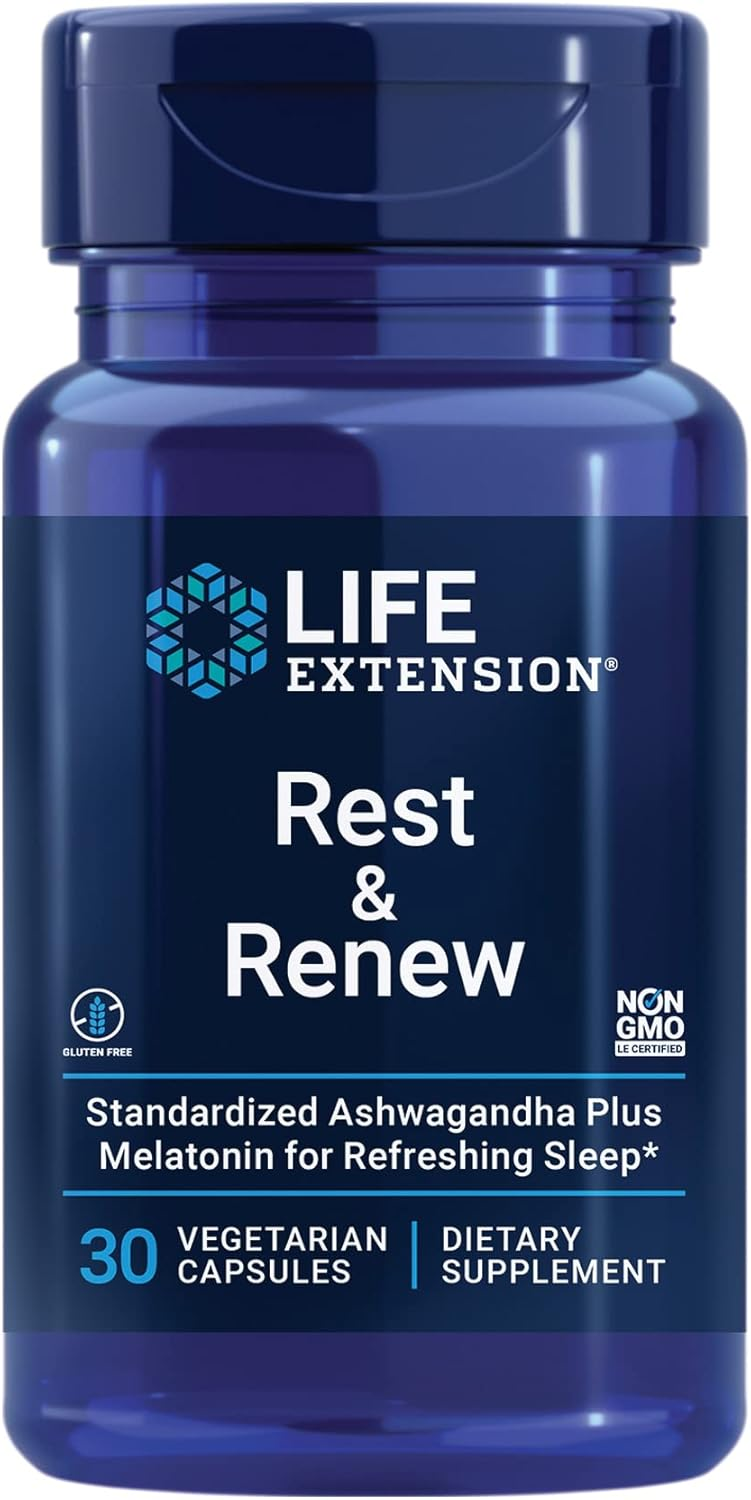
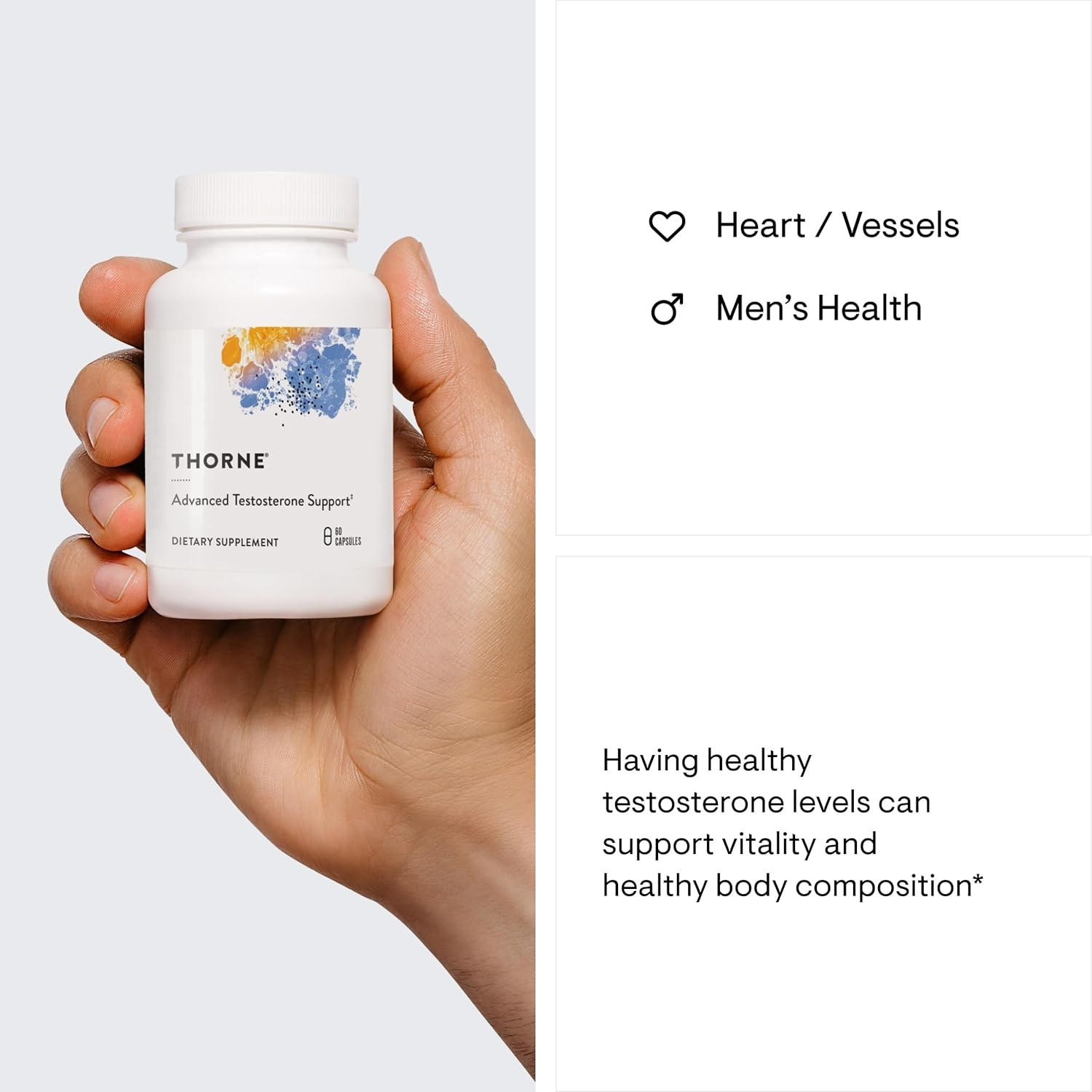

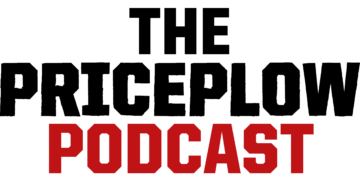
Comments and Discussion (Powered by the PricePlow Forum)